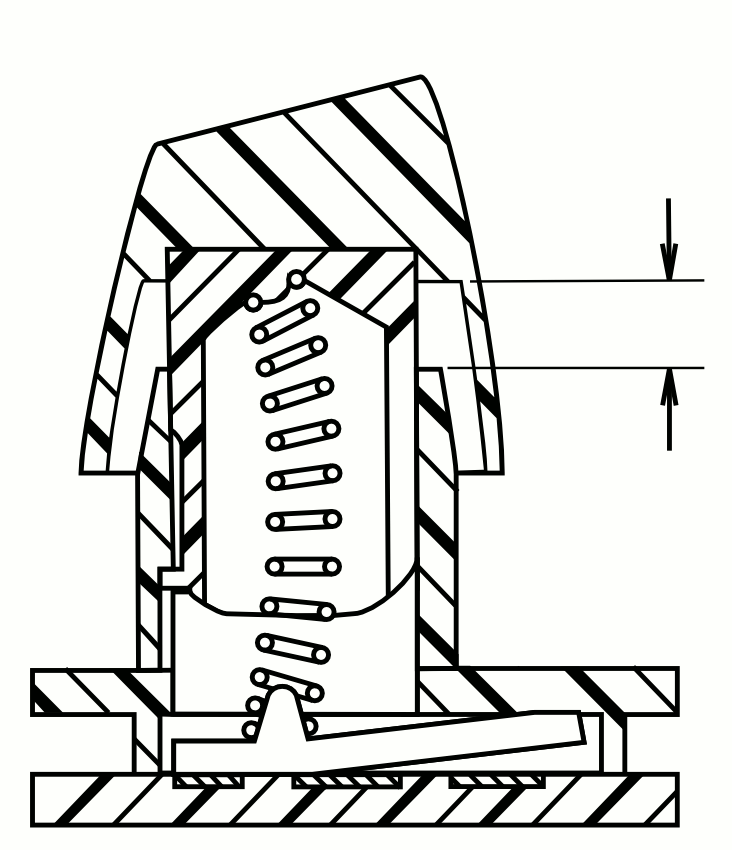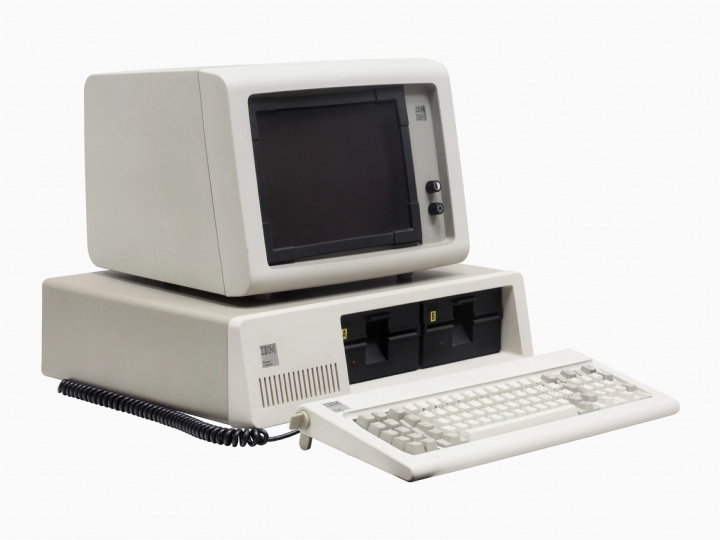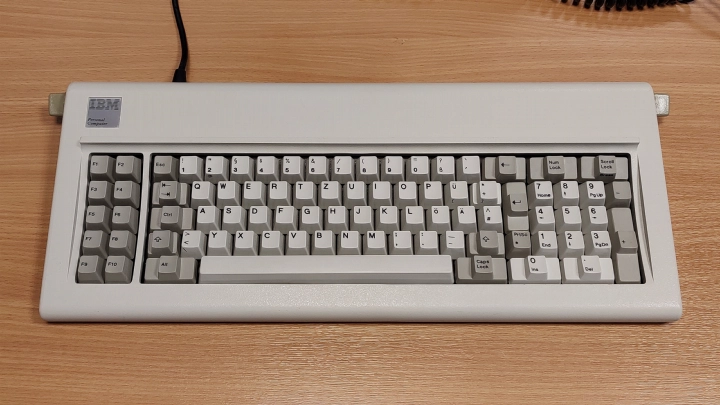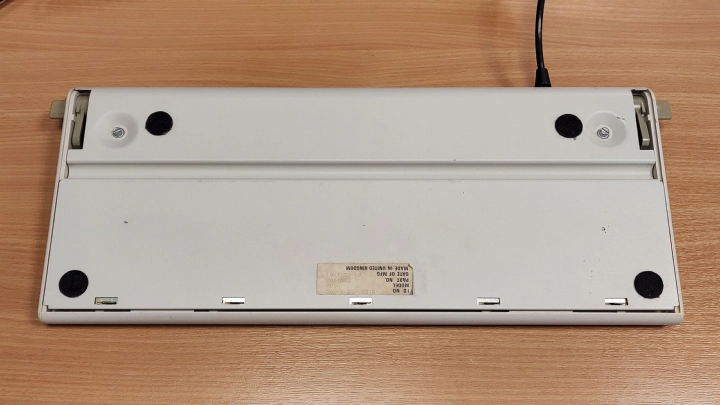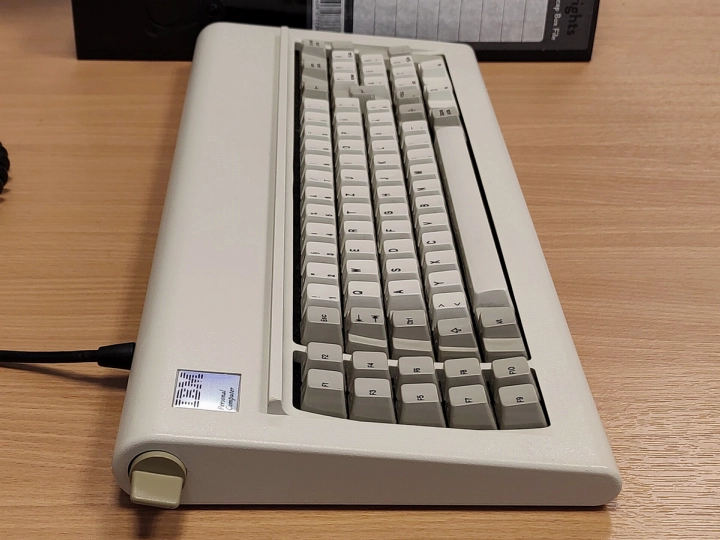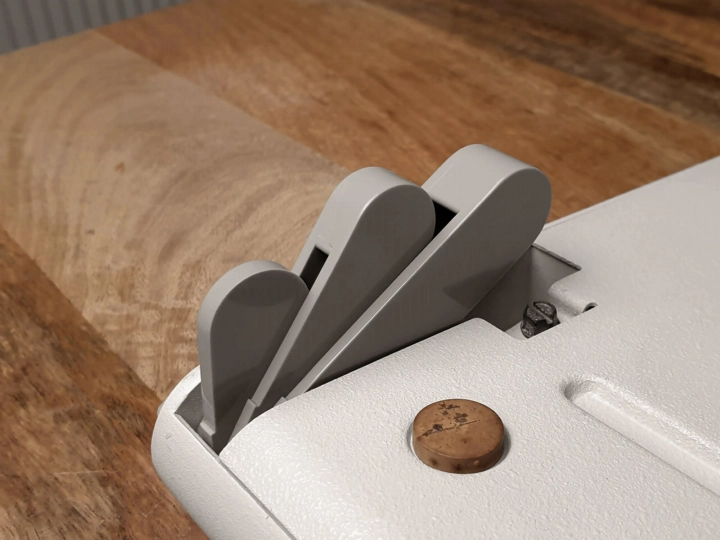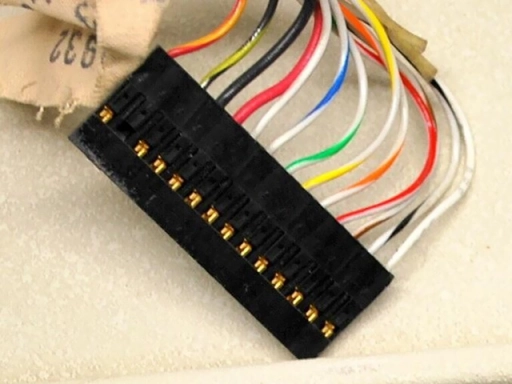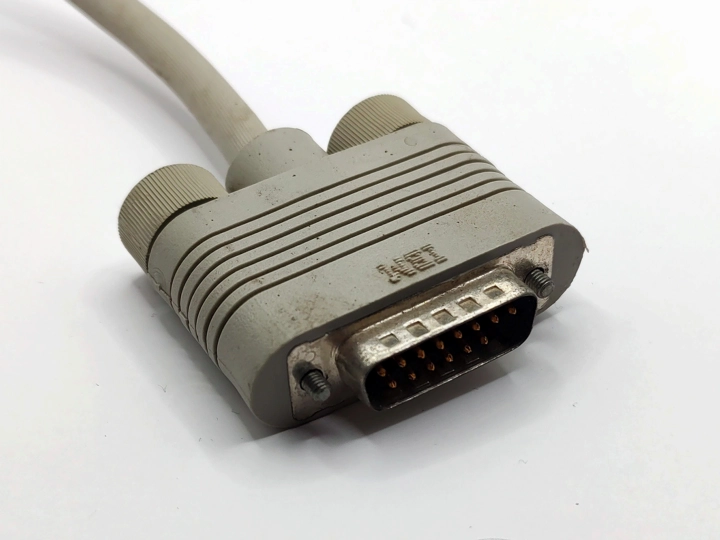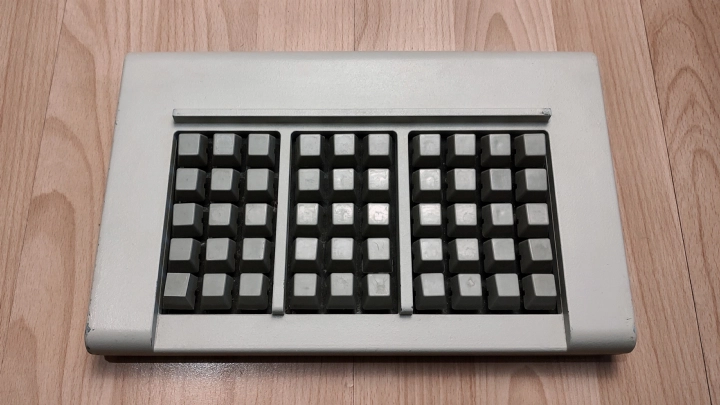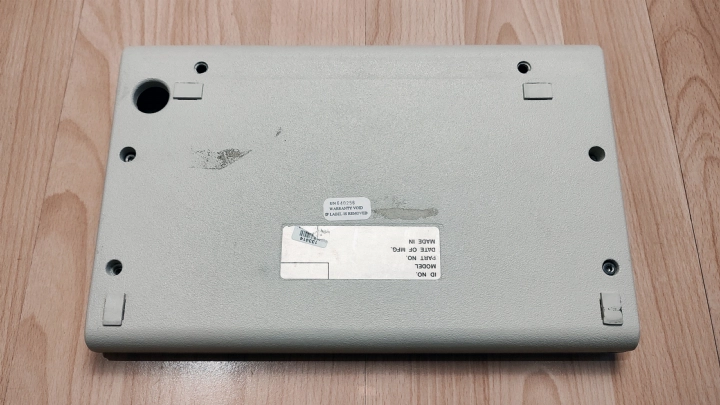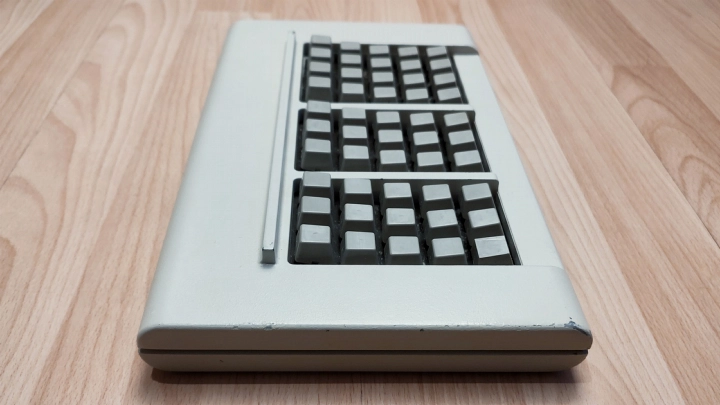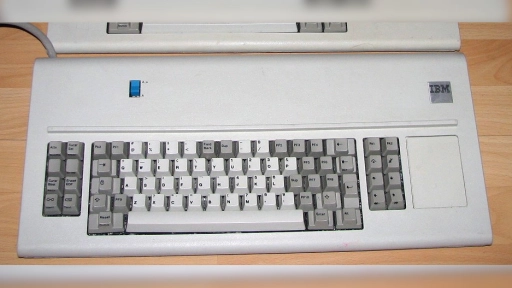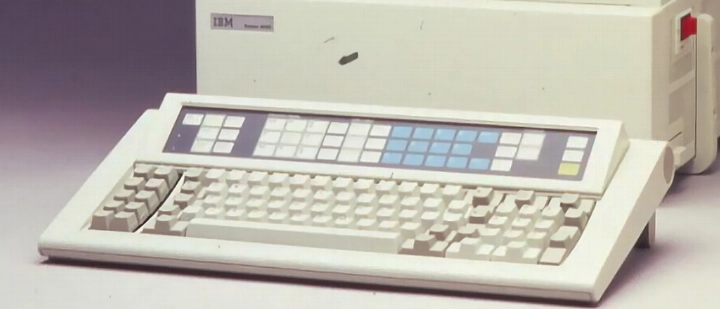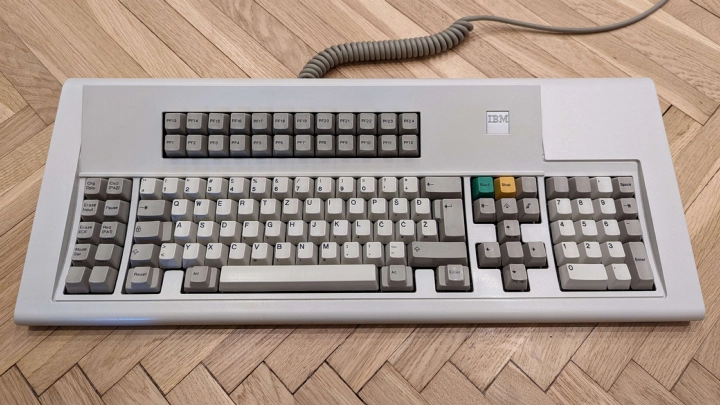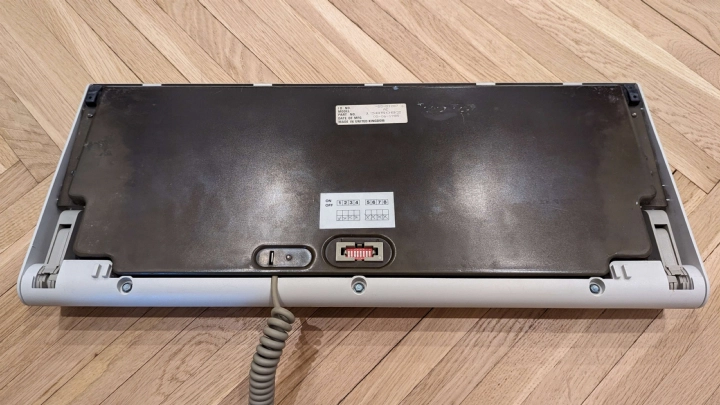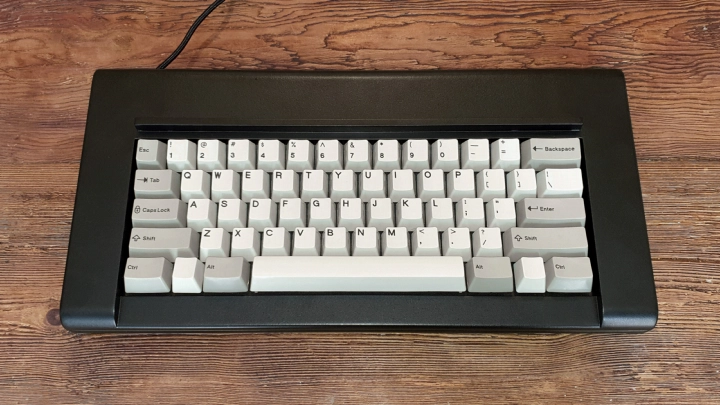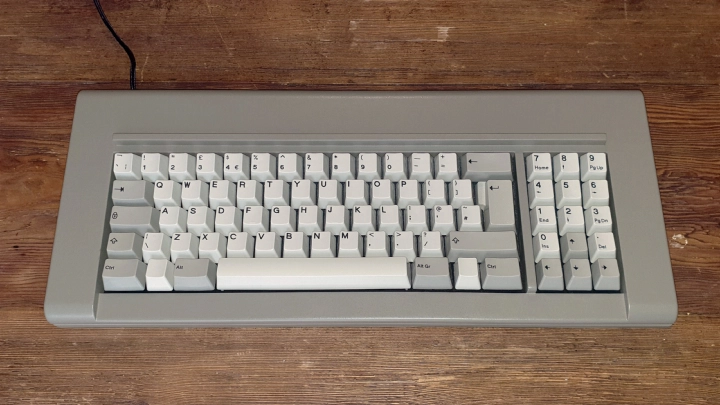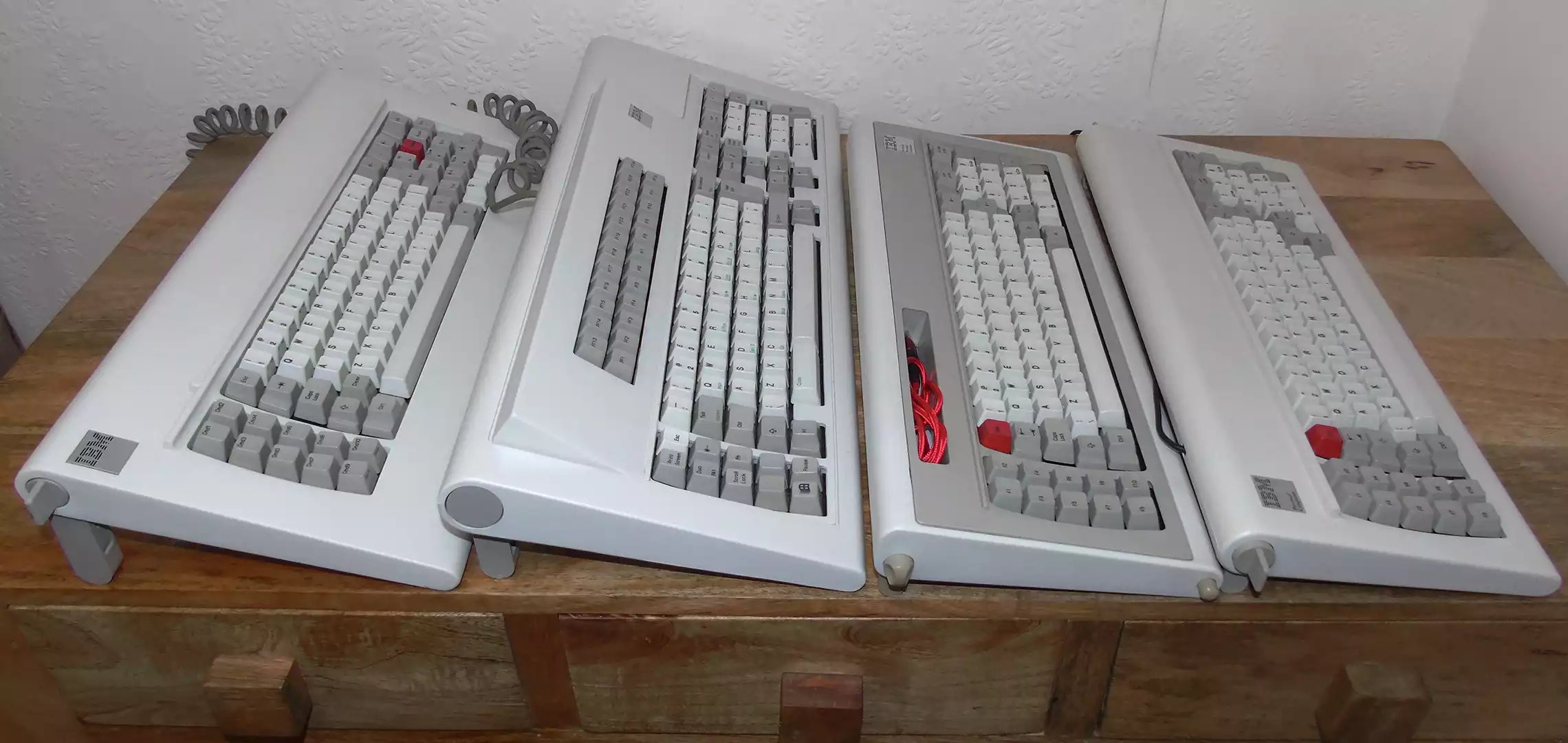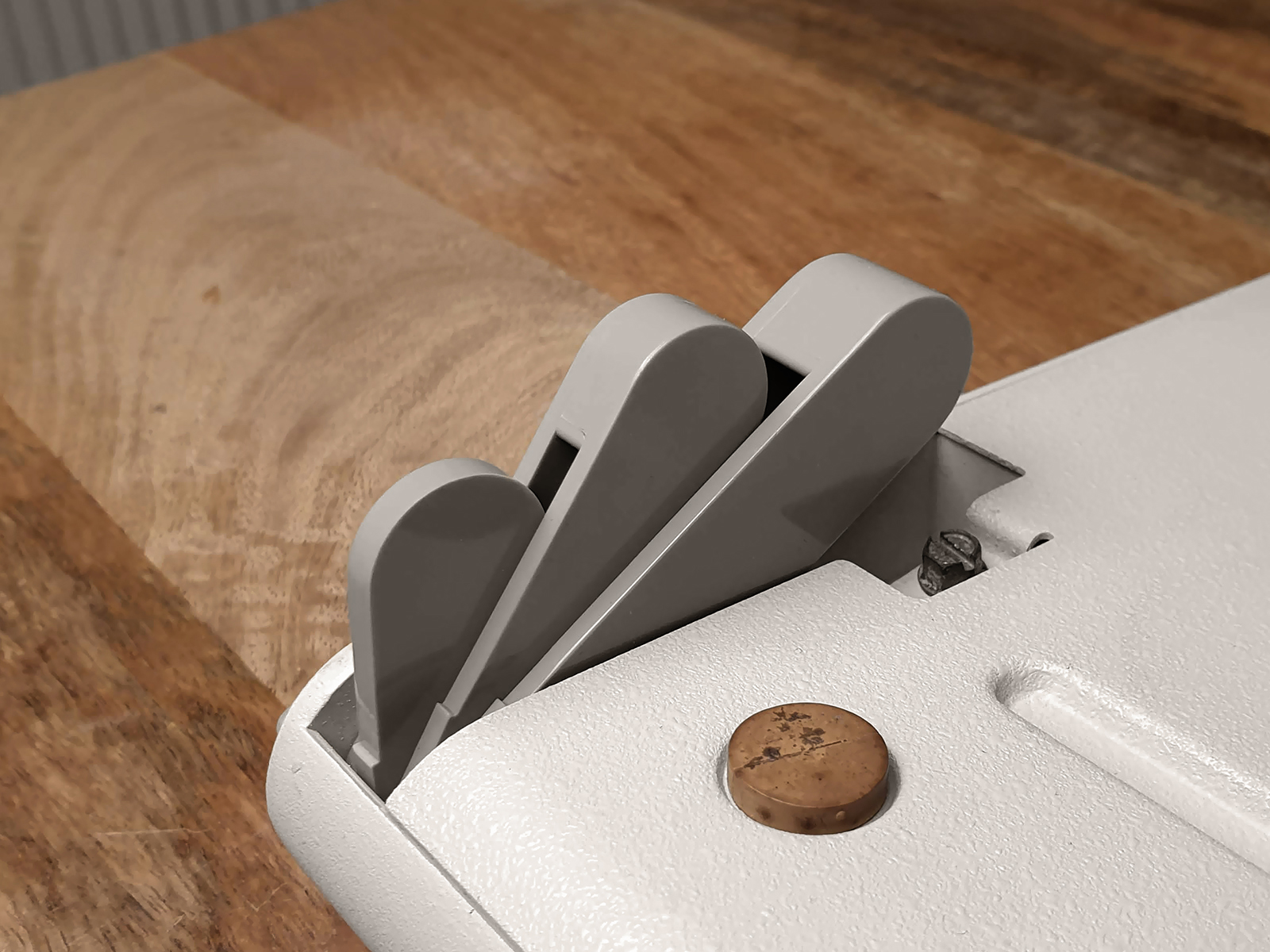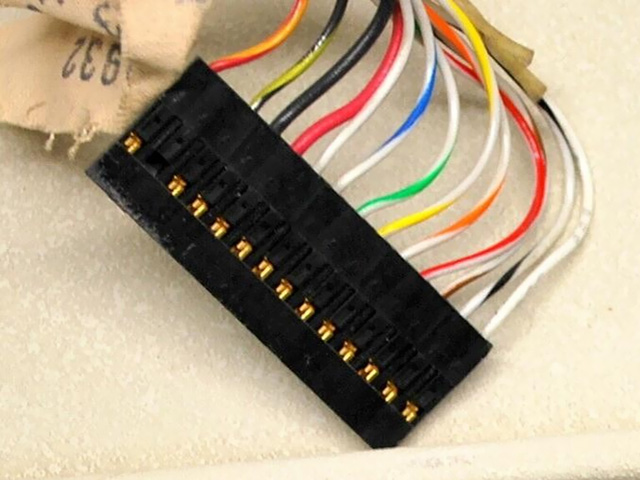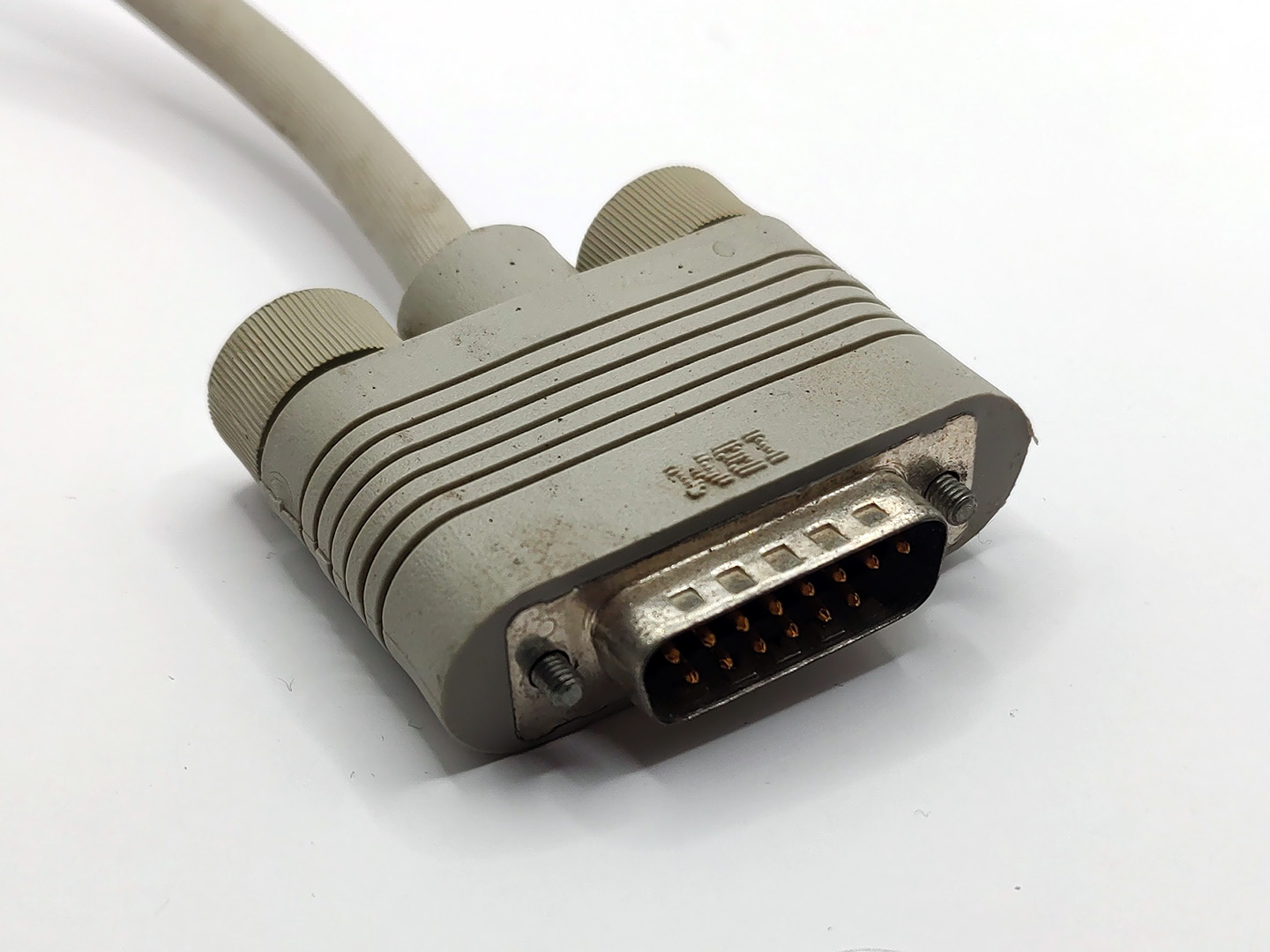IBM's fifth generation of keyboards (aka, IBM Keyboard F, IBM Type F or IBM Model-F)
- Updated
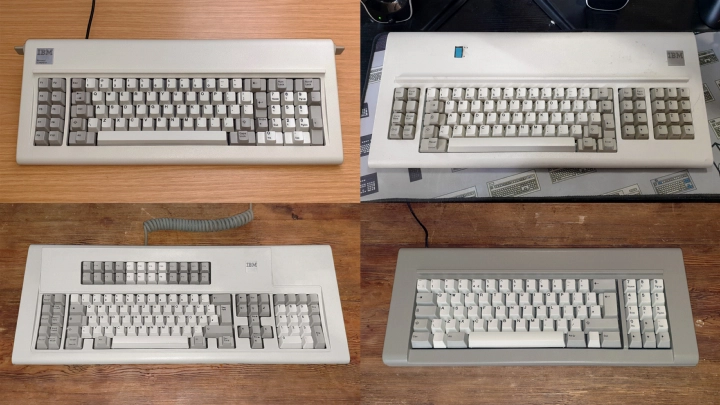
IBM Keyboard F (or Model F as per their printed marketing designation) constitutes IBM's fifth generation of keyboards that was in production from 1981 until around 1994 to 1996. The Model F family shares strong design familiarity between its members and a single switch design much like the previous Model B family but unlike the following Model M family, as Model Fs are all buckling spring keyboards with capacitance sensing with a similar sort of internal assembly. In terms of general recognition, Model Fs are often overshadowed by their successor family; but whilst the average Model F keyboard layout is generally more archaic than the average Model M layout, Model Fs make up for it with their overall superior reliability and technical benefits both provided by the use of capacitance-sensing PCBs instead of membrane assemblies. The Model F's quality auditory and tactile feedback helped cement the original IBM PC as a quality and popular machine, and amongst people who have tried both Model F and Model M keyboards, you'd be hard-pressed to find someone who didn't prefer the key-feel of Model Fs.
Contents
History
The initial seeds of what would become buckling-spring keyboards were planted on 21st May 1971, when the idea of a buckling spring based keyswitch was invented by Richard Hunter Harris and patented as the "catastrophically buckling compression column switch and actuator"[1]. This was before the IBM beam spring (also partially invented by Richard Hunter Harris) was even patented[2] and any IBM Model B keyboards were released. The original patent as-is was never employed on an actual production keyboard, but it established the basic premise of a buckling spring used in a keyswitch design and the goal of combining tactility, actuation, overtravel and return force in one spring. On 30th August 1977, the "buckling spring torsional snap actuator" (once again invented by Richard Hunter Harris) was patented[3], which was a refinement of one of the three designs described in the original 1971 patent that now closely resembled the finished IBM capacitive buckling spring implementation.
Sometime in 1978, IBM System/23 Datamaster's development began, which would become the host of the first Model F keyboard assembly. Design for its hardware was finished by the summer of 1980. On 10th August 1980, the initial drawings for what would become the IBM Personal Computer were sketched. Amongst them is the earliest publicly-available reference to a "Keyboard F", which was made in relation to how the IBM PC's development team planned to modify the Datamaster's keyboard assembly for use with the PC[4]. IBM United States' Raleigh, North Carolina plant (plant code 23) began producing Model F keyboard assemblies in early 1981[5] ahead of their launch. The IBM System/23 Datamaster launched in July 1981, which in its original IBM 5322 "desktop" form-factor had an integrated 83-key typewriter-style keyboard assembly[6].
A month after the Datamaster's launch, IBM released the original IBM Personal Computer (5150) that quickly far eclipsed the earlier system. The 5150 is the ancestor of all modern "x86" PCs[8], but the system's initial success was undoubtedly aided by its included keyboard - the IBM PC Keyboard. In January 1982, Byte Magazine said "it is, by none, the best keyboard on any microcomputer"[9]. Today, this keyboard is referred to as the Model F/XT after March 1983's[10] IBM Personal Computer XT (5160) that also used this keyboard as a way to contrast it against later models. Its complete sub-assembly is the same as the Datamaster's, just the controller electronics are different.
Outside of PCs, Model Fs also became IBM's keyboard of choice for its terminal and enterprise systems for the next 2 years. In September 1981, IBM announced the 4700 Finance Communication System, which included the 4704 Display Terminal and three Model F-based keyboard designs[12] though they would not be released for another year. IBM formally announced the IBM 5291 Display Station and IBM 5292 Color Display Station on 7th July 1982 in the USA[13] and 6th September 1982 in EMEA[14][15], though documentation and part numbers for their keyboards had been available as early as January 1982[16]. The IBM 5291/5292 keyboard design is visually similar to that of the Datamaster's (specifically the 5324 "floortop" keyboard), but it is slightly smaller and features characteristic three-setting riser-style feet that helped give it the nickname "bigfoot".
IBM released the 4704 Model 100 Function Keyboard (50-key) for the 4704 Model 1 in October 1982, which was closely followed by the Model 200 Alphameric Keyboard (62-key) and Model 300 Expanded Alphameric Keyboard (77-key) in December 1982. Around a year later, IBM added another keyboard to the lineup, the Model 400 Administrative Keyboard (107-key), for the 4704 Model 2[17]. All four IBM 4704 keyboards are known for their cast zinc cover set, making the Model 400 the heaviest known Model F, but even the smaller keyboards are heavy by general keyboard standards. Despite this influx of new hosts, around this time, IBM summarised that around 70% of Model F keyboard production capacity was still used for IBM Personal Computer Keyboards[5].
Announced in December 1982[19] and March 1983[20] respectively, the IBM 3104 Display Terminal and IBM 3178 Display Station were released as cheaper replacements for earlier IBM 3270 series terminals and came in two models with slightly different IBM Base Keyboards - 3104-B1/3178-C1 with a 75-key data entry keyboard and 3104-B2/3178-C2 with an 87-key typewriter keyboard respectively[20]. For 3178 only, C1 and C2 would be followed by a 3178-C3 the following quarter and a 3178-C4 by February 1984[21], both with 87-key EBCDIC typewriter keyboards. All IBM 3178 keyboards are known for having solenoids inside.
Also in 1983, the IBM Converged Keyboard emerged via the Model F family, representing a significant step in keyboard layout development. The original 104-key Converged Keyboard (nicknamed "unsaver" or "F104") was announced in March 1983 and first shipped in July 1983 with the IBM 3290 Information Panel[22], sporting a physical layout very similar to the modern ISO layout that would be used by most regional keyboard layouts outside the United States of America. This keyboard is sometimes referred to as the 'shorter version' of the more common and famous 122-key Model F Converged Keyboard (aka, "F122"), but contrary to somewhat popular belief, this larger design that added an integrated 18-key keypad came after the smaller design. An interim 127-key Converged Keyboard was announced and released on 18th October 1983 for the IBM 4980 Display Station[23], whilst the first 122-key Model F Converged Keyboard was announced the same day but made available in Q1 1984 for the IBM 3270 Personal Computer (5271)[24].
After 2 years of terminal keyboard releases, IBM finally released a new PC-orientated Model F in the form of an F/XT variant for the IBM Portable Personal Computer (5155) in February 1984. The 5155 was a 'luggable' version of the PC/XT[25]. Comparing the original IBM Personal Computer Keyboard and this, their complete sub-assemblies are largely the same, but 5155 F/XTs have an aluminium base plate instead of steel, likely to reduce weight. Its entire cover set is also plastic, and the keyboard has a compartment for the cable to be stored in when the keyboard is folded up against the front of the host system. In August 1984, IBM introduced the last wholly new Model F design for the IBM Personal Computer/AT (5170)[26].
After 1984, no new Model F assembly designs were introduced, as the Model F family was thereafter supplanted by the then-new Model M family. Production of standard PC-orientated Model Fs was terminated by the end of the 1980s, however, some Model F keyboards remained in production at least as late as 1994. The 104-key Model F Converged Keyboard was produced as late as 1992 by IBM United States[27], the 122-key Model F Converged Keyboard for the IBM 3270 PC was withdrawn from marketing in August 1994[28], and the IBM 5291/5292 keyboard was produced as late as 1994 by Lexmark[29] (the company formed by IBM's divestiture of their US-based keyboard, typewriter and printer production at Boulder, Colorado and Lexington, Kentucky in 1991[30]). Evidence for production after 1994 is minimal, but it's said Lexmark was at least refurbishing 5291/5292 Model Fs as late as 1996 (despite erroneously identifying them as "Model M" on their rear label)[31]. There is no evidence Unicomp ever produced Model Fs, thus 1996 is likely the last possible year of Model F production.
Buckling springs style keyswitches have actuators that consist of a spring that when pressed deforms (buckles) in a specific way that allows a pivot plate (also called flipper, rocker or hammer) to hit the circuit underneath to make a connection. At rest, the pivot plate is held upwards from any circuit underneath. In the case of Model F keyboards, pressing the switch will ultimately cause the pivot plate to rest atop a pair of capacitance-sensing pads. The capacitance-sensing PCB used to facilitate this were called a pad card by IBM. When a given actuator moves closer to such contacts, a change in capacitance is measured, and eventually registers a key press when the capacitance reaches a certain threshold. The use of capacitance sensing allows for N-key rollover (provided the rest of the controller and possible hosts support it) and is extremely reliable.
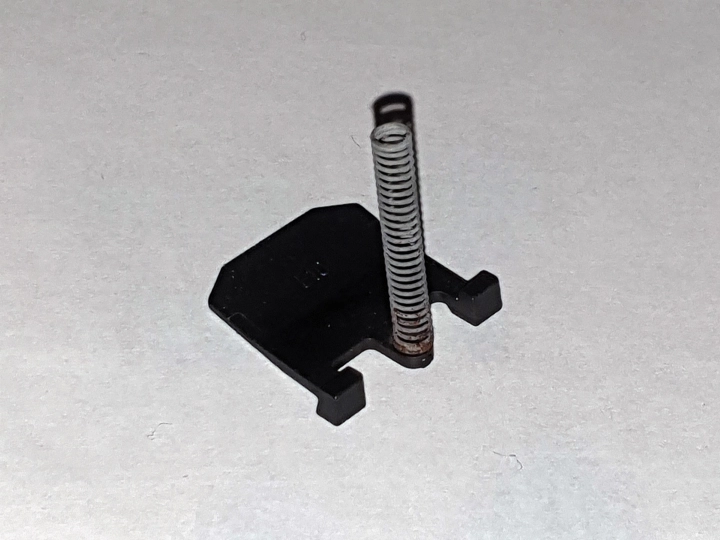
The pivot plate itself is made of a capacitive material. This contrasts with the buckling springs found on the later Model M keyboards, where the pivot plate physically bridges two contacts on a membrane assembly. To differentiate the two implementations, the Model F's style of buckling springs are generally referred to as capacitive buckling springs to refer to its sensing method. Because the pivot plates will accomplish their purpose before their buckling springs are fully compressed, the design is said to "part-way actuate".
Buckling springs are a clicky-tactile switch, considered by some to be the quintessential good clicky switch. The properties of both features are rather unique, as there are seldom switches that feature a similar mechanism. It is best described as having a crisp, 'pingy' click that perfectly matches the point of keyswitch actuation, and having tactility suited for typing but also not over the top. Buckling springs on Model Fs are rated for 100 million key presses and are also on the heavier feeling side of switches, although they are a tad lighter and crisper than Model M buckling springs.
All Model F keyboards are not monocoques - the cover set (outer casing) and a complete sub-assembly can be easily separated. All Model F keyboard assemblies are a sandwich of the following distinct layers:
- The keyboard frame: A curved metal plate that sits top facing and is used to guide keyswitch components and keycaps to their correct positions above the pad card's capacitive sensing pads. They can be casually referred to as a "barrel plate" by enthusiasts, referring to the individual cylindrical frames ("barrels") containing the buckling springs. The keyboard frame will have many cut-outs for these individual barrels.
- A foam layer: Sits below the keyboard frame and likewise has cut-outs for individual keyswitch barrels. It is used to secure these barrels in place and act as a general gasket for the host frame. The thickness of the foam is said to be about 2mm to 3mm[34].
- The keyswitch components: The pad card and buckling spring actuators for it.
- The base plate: Another curved metal plate that sits at the bottom. The base plate along with the keyboard frame are curved to sculpt for the uni-profile keycaps. For most Model Fs, the base plate is steel and has a characteristic "rainbow" appearance due to the chromate plating used on it, however, the IBM Portable Personal Computer Keyboard specifically uses an aluminium base plate and isn't treated or plated. They can be casually referred to as a "back plate" by enthusiasts.
Model F keyboard assemblies are secured together with several tabs surrounding the edges of the assembly, contrasting the plastic rivets most buckling-spring Model Ms employ. This means that the main longevity concern with Model Ms does not apply to Model Fs, but the foam layer is a possible cause for concern as it can invariably degrade with age. However, foam degradation typically doesn't result in a major technical fault, with the typical side effect being that keys are more prone to rotating in their place. It only really becomes a significant issue if one opens up the assembly and allows the old foam to uncompress. Replacing the foam layer in a Model F is a documented procedure on deskthority.
Barrels
"Barrels" are the individual cylindrical frames used to house buckling spring and pivot plate assemblies in a correct place on the keyboard frame. They are technically removable, but a complete keyboard disassembly is required to access them. Reproduction barrels can be purchased from Model F Labs. Two general barrel variants are known:
- "XT-style": This version had a separated peg south of the barrel. It was used for at least the IBM System/23 Datamaster, IBM Personal Computer (5150/5155/5160), IBM 5291/5292, and IBM Base (75/87-key) keyboard designs and their close relatives.
- "AT-style": This version had an attached notch to the bottom-right of the barrel. It was used for at least the IBM 4704, IBM Converged (104/122/127-key), and IBM Personal Computer AT (5170) keyboard designs and their close relatives. This style was also adopted by Model F Labs for their reproduction buckling spring keyboards.
For Model Fs that have a spacebar stabiliser wire that normally sits inside the keyboard assembly (which notably excludes Converged Keyboards), said spacebar and stabiliser get their own frame comprised of a central barrel for the spacebar/keyswitch and two rectangular cuboids on either side to allow protrusions on the spacebar to reach in and grab the embedded stabiliser wire.
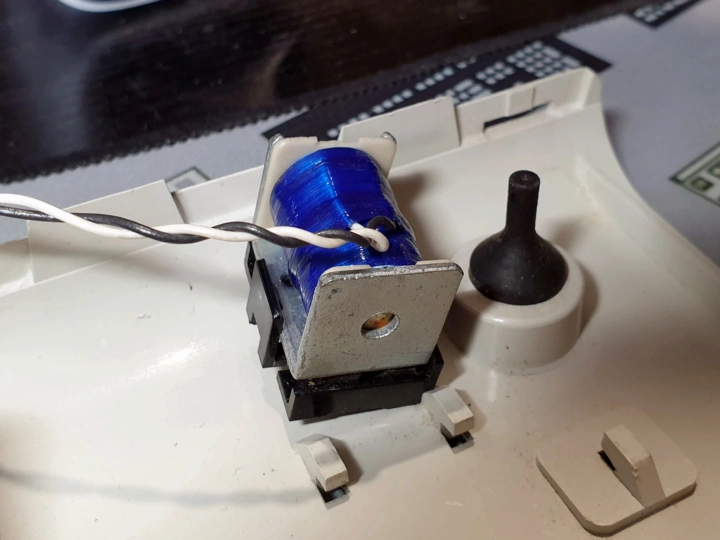
Specifically IBM 3101/7485, 3104 and 3178 Model F keyboards are known for having a solenoid inside the keyboard. These were called "clicker assemblies" (or some variation of) and were used for indicating when the keyboard was enabled by its host terminal/program and in some causes for issuing conditional cues. In recent times, it's also been theorised that it was used to enhance audible feedback, in some ways comparable to the sound pollution of a mechanical typewriter, but this hasn't been confirmed in literature. The practice of including solenoids inside keyboards was more widespread with the preceding Model B family and extinct for the succeeding Model M family, but for this handful of Model F keyboards it would engage for each key-press to generate a distinct sound. The practice was likely viewed as 'excessive' by the 1980s and these Model Fs only included them since they were for terminals that either had an earlier Model B keyboard with an included solenoid available for it or directly evolved from terminals that had Model B keyboards with included solenoids. As of late though, solenoids in keyboards have seen somewhat of a resurgence in popularity, thus IBM 3104/3178 keyboards and Ellipse's reproduction F62 and F77 are sometimes sought after specifically for their solenoids or possible support of them.
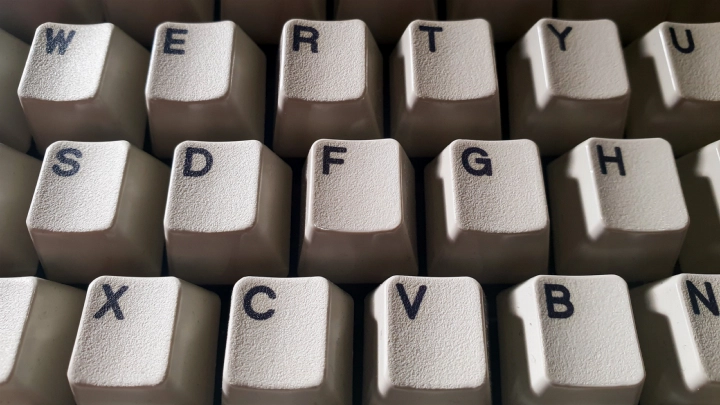
Model Fs are known for their high-quality unique-mount PBT dye-sublimated keycaps. Versus the most common keycap material, ABS[35], PBT is more durable, does not degrade/yellow with age, UV or heat exposure, and will keep its texture for longer without shining[36]. Dye-sublimation is also a very durable text printing method that sinks dye material into the keycap's plastic itself, meaning there is nothing to quickly wear off as would be the case with pad-printing or silk screening. This means many vintage Model F keycaps will still be in good condition, requiring at most a good cleaning.
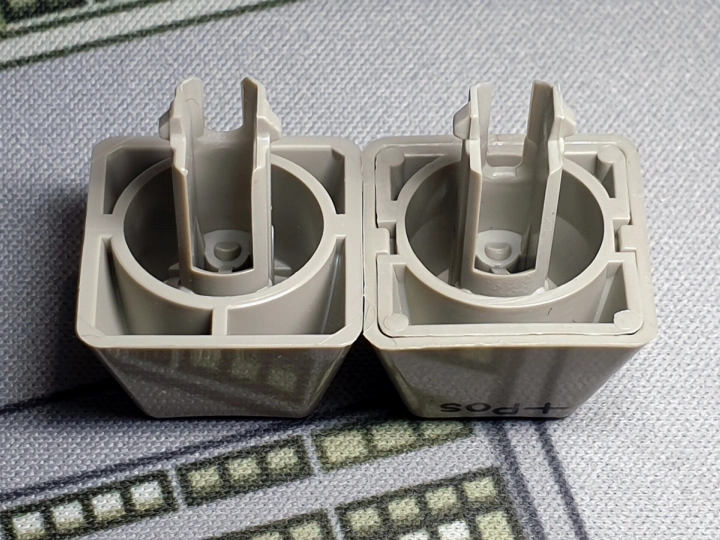
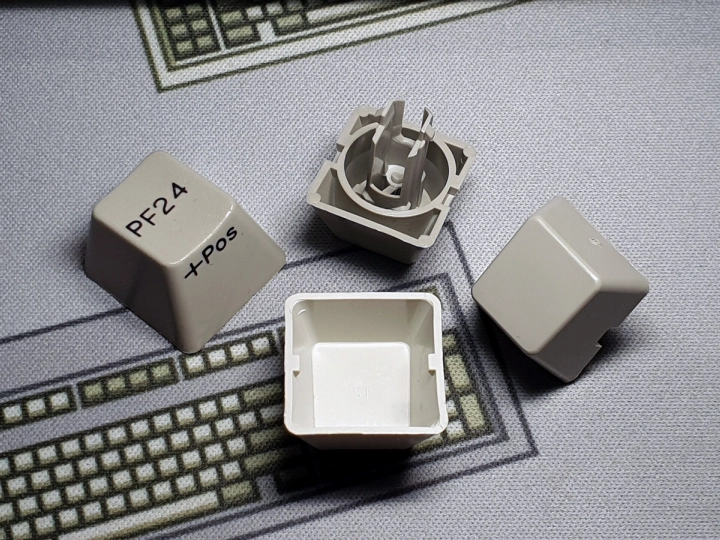
Model F keycaps are uni-profile, meaning a given keycap can be swapped with any other provided both are of the same unit size. This allows every Model F to have innate layout customisability without the user needing to worry about mismatches in keycap sculpting - sculpture is instead provided by the curved internal keyboard assembly. This, for example, makes it easy for a user to visually change between QWERTY and QWERTZ or visually configure a Colemak or Dvorak layout (operating system level changes would also be needed to make the changes functional, of course).
Furthermore, some Model Fs such as the 104-key and 122-key Converged Keyboards have two-piece keycaps that allow the user to swap around their layout around without needing to completely dismount the entire keycap. The two pieces are known as the stem (the part that always stays in the barrel) and the keytop (the part that can be easily swapped). That said, most Model F variants that are easily accessible these days lack this capability. Model F and Model M (buckling spring versions only and excluding Models M1, M2 and M15) keycaps are fully interchangeable granted the correct unit size, thus Model F keycaps can be replaced with Model M keycaps including Unicomp keycaps. Today, Unicomp offers keycaps in a variety of colours and as blanks or with dye-sublimated legends on their website. They can be bought individually or as part of the many predefined sets they offer[37].
Rear labels
More information: Keyboard Rear Labels topic
Model F keyboards can feature strong documentation of the keyboard's type and date of manufacture in the form of a real label sticker casually referred to as a 'birth certificate'. This practice is best associated with Model Ms as early Model Fs featured weaker documentation, but Model Fs produced after 1982 generally have external and internal labels of some sort.
External rear labels
The external rear label is used to display information about the keyboard as a whole and when present is stuck to the bottom cover piece. As a summary of the main data points of interest presented on the external rear label:
- Part (and/or feature and/or FRU) number: a unique and typically 7-digit number assigned to each keyboard release. Whilst intra-part number varieties may exist, a given part number is expected to have a set number of features and specs. For example, a P/N 6110344 Model F is always expected to be an IBM 3270 PC 122-key Model F.
- "Model F" designation: except for IBM UK made and early models, most Model Fs proudly state what they are.
- Date of manufacture/assembly: exactly what you expect, the date when the keyboard's manufacturing process was complete. The date format itself can be specific to a given factory's region or OEM convention.
- (IBM US only) Shop date: when present, the smaller supplement rear labels may have a four-digit shop date as a replacement or in addition to a 'proper' date as mentioned above. The shop date incremented with US working days with day one believed to be around the formation of IBM Office Products Division in 1964[38].
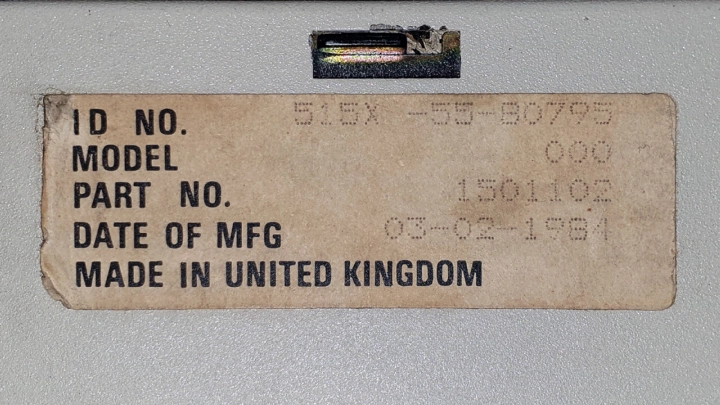
Internal rear labels
The internal rear label is used to display information about just the inner keyboard assembly and its fitted keycaps rather than the whole keyboard and when present is stuck to the keyboard assembly's base plate. It doesn't represent the type or revision of controller or cover set of the whole keyboard. As such, multiple unique outer part numbers can share the same internal part number as evidenced by the fact the IBM Personal Computer Keyboard P/N 1501100 and IBM System 9000 Family Standard Keyboard P/N 4780898 share the same P/N 4584656 inner assembly. This is because both keyboards share the same layout and pad card, with the only differences being with the cover set and what host system the keyboard was bundled with.
- Part number: like before, the unique and usually 7-digit part number that is assigned to just the internal keyboard assembly.
- (Excluding IBM US) Date of manufacture/assembly: just like the external real label, the internal one has a date for when the keyboard assembly's manufacturing process was completed and the format can once again be specific to a given factory's region or OEM convention. The dates of the internal and external rear labels can differ slightly.
- (IBM US only) Shop date: like before, the shop date is an IBM US only convention that is four digits and with US working days with day one believed to be around the formation of IBM Office Products Division in 1964.
Official
Somewhat like Model Bs, Model Fs were a keyboard family largely found in enterprise rather than in markets where marketing speak in the keyboard's name would be needed to drive sales or identity (ie, consumers, home, etc.). As such, many Model Fs [that were intended for one system only] were officially named after their host system with maybe an extra term referring to its intended operator use like "Data Entry" or "Typewriter" in the name. For example, IBM 3178-C3 EBCDIC Typewriter Keyboard or IBM 3180 Display Station Keyboard Element. Even for the early IBM PC keyboard releases, they were named after their host system like "IBM Personal Computer AT Keyboard". Model Ms would later start practices such as descriptive naming, the inclusion of marketing buzzwords and naming after a specific technology employed. The closest Model Fs got to this was referring to the IBM 3104/3178 keyboards as "IBM Base Keyboard" and the 104/122/127-key keyboards as "IBM Converged Keyboard"[43].
Some Model F lines employed sequential numbering for its members like Model Ms famously did under Lexmark in the 1990s, but it wasn't a universal or consistent practice. IBM 4704 Display Terminal keyboard models were numbered Model 100 (50-key keyboard) through 400 (107-key keyboard) and IBM 3178 Display Station keyboards took model numbers C1 through C4 after its host system. But both conventions are unrelated and limited to just those keyboards.
Community
Modern Model F naming is largely based on the host system's numbers or the number of keys a model has. For example, IBM 3178 keyboards are always simply called "3178" rather than writing or speaking their full name plus whether they're data entry or typewriter version. IBM 4704 and 122-key keyboards are almost always referred to simply by their number of keys plus an "F" at the start to differentiate against possible Model M versions of the same keyboard; "F50" (IBM 4704 Model 100), "F107" (4704 Model 400), or "F122". The IBM PC keyboards are generally referred to by the two letters IBM assigned to the two follow-ups to the original PC - XT and AT. Thus, the original IBM PC Keyboard is generally referred to as "F/XT" and the IBM PC/AT Keyboard as "F/AT" - both also with or without the "/", spoken as an initialism. To stress specific features or sizes, some nicknames are also given like "unsaver" for the 104-key Model F "unsaver" to describe the oxymoronic nature of it being a "space-efficient" version of an even-larger keyboard but still as large as some modern full-size keyboards, and "battleship" for 122-key Model Fs to highlight their sheer size.
eg, P/Ns 1643374, 1643377, 1643380, 1643383, 1643395, 1860765, 1860768, 1860771, 1860777, 1860783
The IBM System/23 Datamaster was a series of general-purpose microcomputers first introduced in July 1981 with the IBM 5322 "desk-top" Computer[46] and followed by the IBM 5324 "floor-top" Computer announced in February 1982[47]. Parts of the system (including its display, floppy interface, expansion bus and keyboard assembly) were reused for the slightly later but more famous IBM PC[48].
This "desk-top" version of the Datamaster is currently the earliest known bearer of a Model F keyboard assembly and a buckling spring keyboard at large. The 5322 keyboard assembly is embedded inside the host Datamaster, so it's not user-removable. But the assembly itself already establishes the hallmarks of the most common Model Fs. Its physical layout is derived from the Model B era IBM 5251/5252 Display Station Typewriter Keyboard, much like the more common IBM Personal Computer Keyboard that soon followed the Datamaster.
The 5322 keyboard assembly has a cover that must be removed from the host Datamaster before itself can be removed. Being an embedded keyboard design, the 5322 keyboard assembly cabling is also internal. It's a simple 1x14 (keyboard-side) to 2x8 (planar-side) header cable with no casing or wrap containing all the wires. It's used to transmit IBM 525X-style scancodes via a parallel interface (the scancode bits have dedicated wires)[49].
eg, P/Ns 8257796, 8529401, 8529404, 8529412, 8529416, 8529418, 8529420, 8529422, 8529424, 8529428
The "floor-top" version of the Datamaster was arranged differently to the "desk-top" version, being a computer with separate logic, display and keyboard modules instead of being an all-in-one computer. The resulting keyboard resembles the IBM 5291/5292 Display Station Keyboard released just a month before the 5324, but this keyboard is slightly larger and has only single-setting riser feet. The keyboard layout is the same as the 5322's.
According to the IBM 5324 Service Library, the 5324 keyboard module's cover set (P/N 8529383) is painted. The complete sub-assembly inside is the same as their IBM 5322 counterparts, including their part numbers. For example, 5324's P/N 8529401 (US English) keyboard module contains a P/N 1643374 complete sub-assembly, the same as 5322's US English keyboard assembly part number. The controller card attached to the keyboard's pad card is the same design as the 5322's, however, a keyboard adapter card (P/N 6061008, also called a keyboard driver card[50]) is attached. It connects to the controller card's 1x14 header, then the keyboard cable connects to the adapter card via its 2x16 header and terminates in a DB-25 plug that connects to the IBM 5324's connector panel. The keyboard adapter card's purpose is unclear, as ultimately the 5324 uses the same parallel-based keyboard interface with IBM 525X-style scancodes[51] as the 5322.
eg, P/Ns 1501100, 1501101, 1501102, 1501104, 1501105, 1503206, 1801449, 8116083, 8529297
The IBM 5150 Personal Computer was an Intel 8088-based microcomputer released in August 1981 that thanks to its open architecture and software support became the basis of the "x86" PC family that continues to dominate desktop and laptop PCs to this day[8]. The IBM Personal Computer Keyboard is the most common and widely considered to be the definitive Model F keyboard. After debuting with the 5150, it was later reused with the IBM 5160 Personal Computer XT released in March 1983[10] which is what the the PC Keyboard derives its common nickname from - F/XT. The F/XT played an important role in establishing the PC as a high-quality computer and solidifying buckling spring-based keyboards as IBM's go-to for well over a decade after its release. Relative to the competition, the F/XT brought unsurpassed reliability and build quality to the mix but arguably suffered from a layout too different from others. Most notably, the F/XT along with its predecessor and successors are criticised for their use of stepped multi-unit keys to reduce the need for stabilisers outside of the spacebar.
eg, P/Ns 1305671, 1305672, 1305675, 1305676, 1305677, 1305678, 1305679, 1305687, 1415880, 1415889, 1437057
The IBM 6714/6724 Electronic Typewriter series (models 65, 85 and 95) was the second generation of the IBM Electronic Typewriter, replacing 6713/6723 models 50, 60, 75 and 175. Electronic Typewriters 65 and 85 were announced in EMEA on 18th November 1982 with a planned first customer shipment in March 1983 and December 1983 respectively[55]. Electronic Typewriter 95 was announced on 9th January 1984 in the U.S.A and 17th January 1984 in EMEA for immediate availability[56][57]. The IBM Electronic Typewriter was envisioned as a smarter alternative to the popular IBM Selectric, gaining some internal processing capacity via electronics rather than relying on electrically-powered mechanical elements. They use the 96-character "golfball" typing element design like IBM Selectric III, but the element is powered by solenoids rather than an elaborate whiffletree mechanism.
Whilst the previous Electronic Typewriter generation used a reed-sensed Card Punch-like keyboard assembly, the second generation uses a capacitive buckling spring keyboard assembly. This move reduced the keyboard's overall size and reduced apparent complexity as the keyboard has less large metal parts and does not need to be reset by the host typewriter after each key press. They are also the smallest alphanumeric as standard Model F design with just 57 keys. However, some details of its design are notably different to all other Model Fs as they have an 0-ring under each key and the assembly itself is held together by plastic rivets much like most Model M family keyboard assemblies. A controller card is connected to the pad card at a right-angle via an edge connector. Their spiritual successor are the IBM Wheelwriter and Quietwriter electronic typewriters.
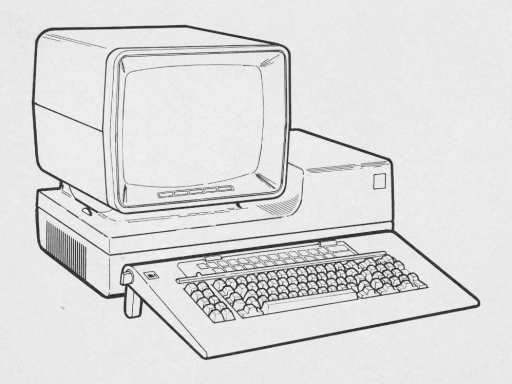
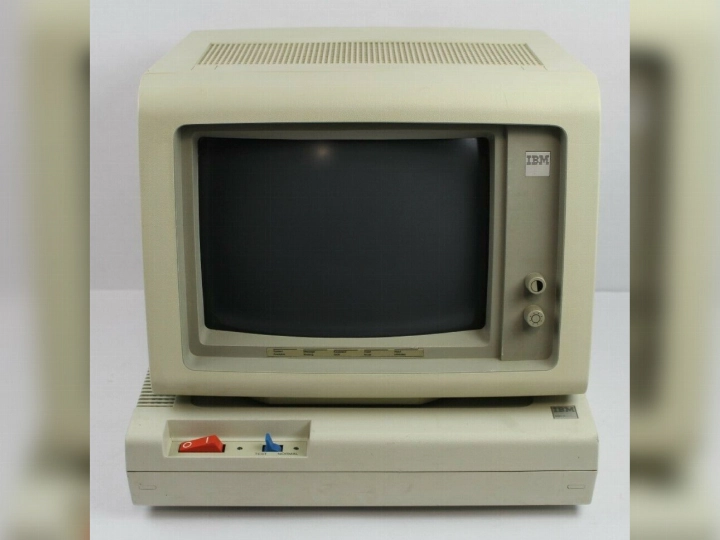
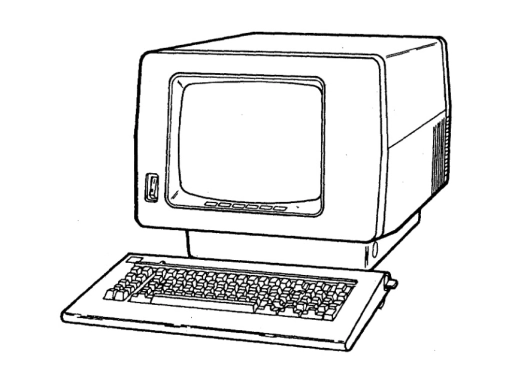
The IBM 5291 Display Station (Models 1 and 2) was an IBM 5250-compatible terminal first released in January 1982 that was designed to be a low-cost replacement for the IBM 5251 Display Station Models 1 and 11 from the late 1970s. Model 1 and 2 differed on the monitor and lower-unit arrangement. The IBM 5292 Color Display Station is a variant of 5291 that adds 7-colour support to the display[60]. The IBM 529X Keyboard was the earliest discrete terminal Model F keyboard in production, resembling the IBM 5324 Floortop Keyboard and using the same internal keyboard assembly as Type I Model F/XTs. Its physical and functional layouts are derived directly from the 525X-83 type Model B keyboard. The 529X is noted for its combined F1 to F24 row across its number keys originally used for inserting, deleting and moving data and controlling cursor position, and its "Cmd" (command) key used to access [host-stored] programmable command functions. A notch is present on the left side of the protrusion above the keyboard assembly to help old templates used for writing function names onto[62]. The 529X Keyboard lacked a controller that could generate scancodes, making the keyboard essentially 'brainless' on its own. Compared to its stylistically similar 5324 counterparts, the 529X Keyboard is slightly smaller. But the 529X Keyboard famously features three-setting riser feet that is presently the largest known IBM keyboard feet, which coupled with its bezel size earns this keyboard the nickname "bigfoot" in the modern keyboard community. The original IBM 5291 Model 1 version of the keyboard connected internally to the terminal via a 14-pin IDC connector, whereas the 5291 Model 2 (and presumed 5292) versions used the more familiar external DA-15 connector.
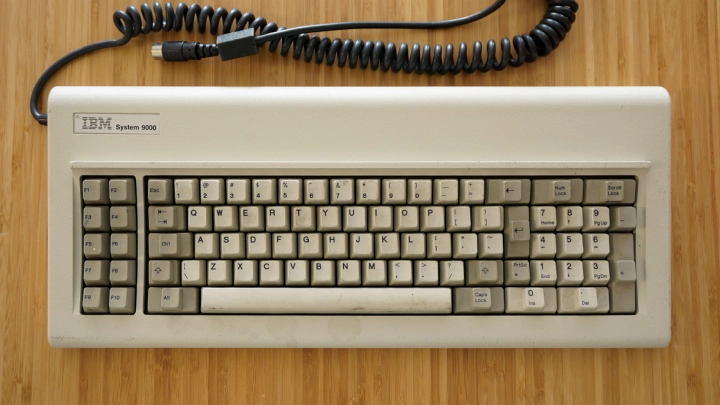
The IBM Instruments Computer System 9000 Keyboard (P/N 4780898) is a variant of the Model F/XT introduced in May 1982 for use with the titular IBM CS/9000 laboratory computer. It's mechanically identical to the IBM PC Keyboard but lacks flip-out riser feet, traded the square IBM badge for a rectangular one reading "IBM System 9000", and its cable now sprouts out from the left side of the keyboard instead of the back. Due to IBM's repositioning of the CS/9000 as a family of computers in 1984 (the CS/9000 proper was also renamed System 9001), this keyboard later became known as the Standard Keyboard due to the availability of the System 9002's Hybrid Keyboard.
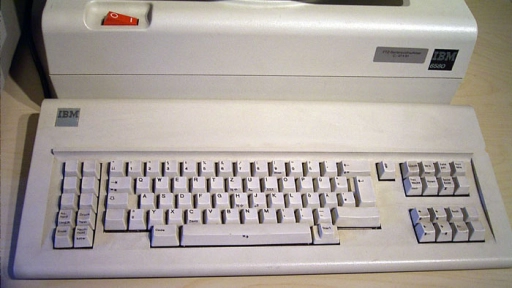
The IBM 6580 Displaywriter System was a diskette-based word processing system that was originally released in June 1980[65] with a Model B-based keyboard. In November 1982, IBM announced this optional low-profile alternative designated the "Type B" keyboard with the original keyboard retroactively designated "Type A". The Model F-based Type B keyboard is plug-compatible with the original keyboard but is far thinner and is capable of being adjusted for 5-degree and 12-degree typing angles which IBM then touted as being "ergonomically designed"[66]. The Type B keyboard features the same functional layout as the 96-character Type A keyboard. In a way, the keyboard's alphanumeric section provides an early glimpse into what would become the ISO layout with 1985's IBM Enhanced Keyboard, making the Type B one of the most modern-looking early Model F keyboards.
The 50-key IBM 4704 Display Station Model 100 was the first and smallest keyboard for the IBM 4700 Finance Communication System's 4704 Display Station, introduced in October 1982. It's the second smallest known alphanumeric Model F assembly behind the Model F-based IBM Electronic Typewriter models 65, 85 and 95. It's a matrix-style keypad with three key segments, usually featuring 45 transparent keys and 5 hard-set function keys. The Model 100 acted as a sort of macro pad for the system by allowing the user to map functions to those 45 transparent keys and put custom labels underneath them. It's colloquially referred to as the "F50". Its internal assembly design would later be altered to become the Model M-based IBM 50-key Keyboard.
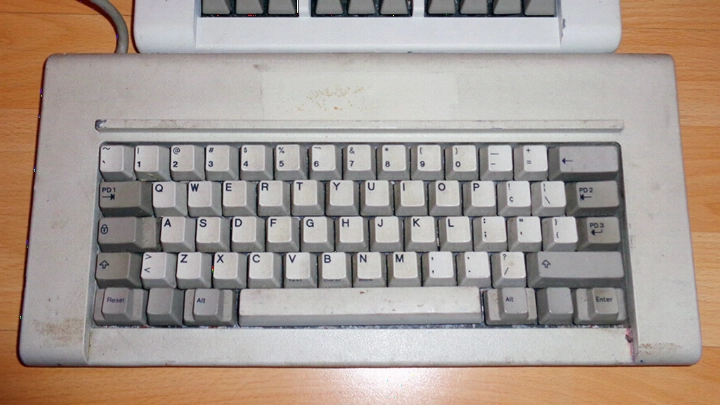
The 62-key IBM 4704 Display Station Model 200 is the smallest alphanumeric keyboard for the IBM 4700 Finance Communication System's 4704 Display Station, introduced in December 1982 alongside the 77-key Model 300. The Model 200 was intended to be the most basic full input device for the 4704, providing only limited user-assigned functions. Nicknamed "Kishsaver" after kishy.ca who introduced them to the modern keyboard community, these have become very desirable due to it being an example of an early 60%-layout keyboard. Starting in 2016, Model F Labs has developed and marketed a modernised recreation of the Model 200 designated as "F62".
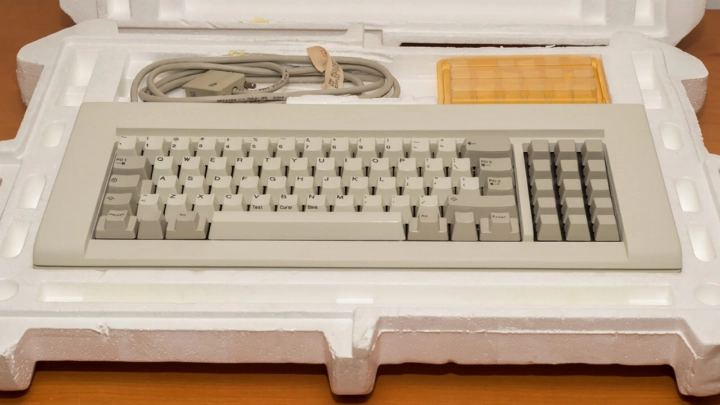
The 77-key IBM 4704 Display Station Model 300 is an intermediate-sized alphanumeric keyboard for the IBM 4700 Finance Communication System's 4704 Display Station, introduced in December 1982 alongside the 62-key Model 200. The Model 300 is essentially the same as the Model 200 but comes with an additional 15-key transparent-capped keypad on the right-hand side of the keyboard for user-assigned functions. Starting in 2016, Model F Labs has developed and marketed a modernised recreation of the Model 300 designated as "F77".
The IBM 3104 Display Terminal and 3178 Display Station were both low-cost terminals announced in December 1982 and March 1983 respectively. The IBM 3104 was intended for IBM 8100 Information System or IBM 4321 and 4331 Processor applications[19], whereas IBM 3178 was designed to be used in a 'traditional' 3270 setting by connecting to an IBM 3274 Control Unit or 3276 Control Unit Display Station[20]. Despite that, both were IBM 3270 Information Display System family terminals and provided IBM 3278 Model 2 equivalent functionality but did not support many 3278 optional features.
Along with its typewriter-like counterpart, the 3104/3178 Data Entry Keyboard is a part of the IBM Base Keyboard family that originated in 1977 during the Model B keyboard era[43]. Specifically, this 75-key keyboard uses the physical layout from the 327X-75 type Model B keyboard. It constituted only 1 of the 4 total 3104/3178 keyboard variants, which was used exclusively with 3104 Model B1 and 3178 Model C1. It lacked the right-most keypad that the typewriter version of the keyboard had, but whereas earlier IBM 3270 family keyboards were also physically smaller when they lacked one, the 75-key 3104/3178 keyboard was the same size as its 87-key counterpart but simply had a blanking plate covering where the keypad would normally go. The 75-key keyboard assembly's barrel plate is shorter than the 87-key's, meaning it cannot be 'upgraded' to an 87-key physical layout without replacement parts and a replacement barrel plate. Being a data entry keyboard, it had a functional layout similar to an IBM Card Punch Keyboard. B1 and C1 keyboards seem to share part numbers.
Amongst Model Fs, the 3104/3178 keyboard design was very distinct. They had a large area of unused space above the keys (a trait shared with only the 3101/7485 Terminal Keyboard), with only a single blue-coloured toggle switch and silver-square IBM badge consistently interrupting it. This switch was used for toggling the terminal's display between mixed-case or uppercase-only characters and gives these keyboards their common nickname "blue switch Model F". Some 3104/3178 keyboards may have what appears to be a compartment outline in this area, which was likely the result of shared tooling with the aforementioned 3101/7485 keyboard that had a compartment in this location for covering DIP switches - for 3104/3178 keyboards, it had no purpose. Just above the keys, a very pronounced raised section spanning the width of all the keys was present which can be used to hold small items or layout diagrams in place. Underneath the keyboard, there was a compartment used for storing the host terminals' Problem Determination Guide for convenience. Whilst 3104/3178 keyboards had no native retractable feet for adjusting typing angle, there were clip-on feet (P/N 5641299) available. Another notable feature of the 3104/3178 keyboards was their included solenoids used as a "keyboard clicker" that would engage as an audible confirmation for a registered key. The clicker could be toggled on or off with the bottom-right-most key of the left 4x2 key bank. 3104/3178 keyboards had a grey cable terminating in a male DA-15 plug.
IBM 3104/3178 Typewriter Base Keyboard (1982)
31XX-87 type Model F (also known as 3178 (C4), 340X (C2) or 380X (C2/C3) type Model F)
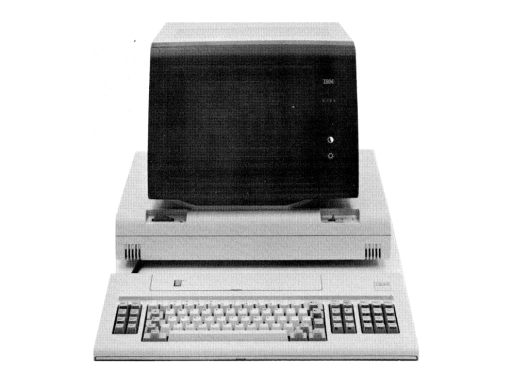
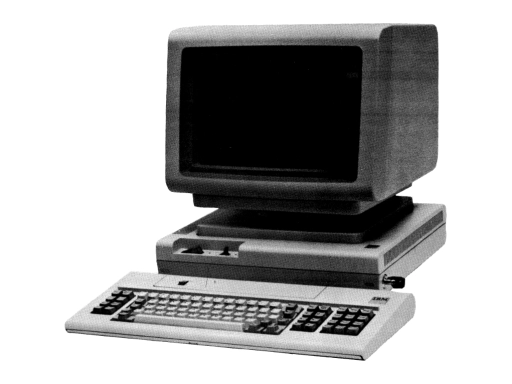
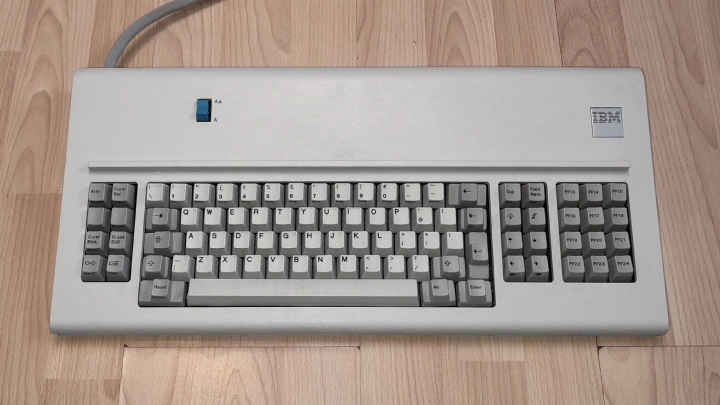
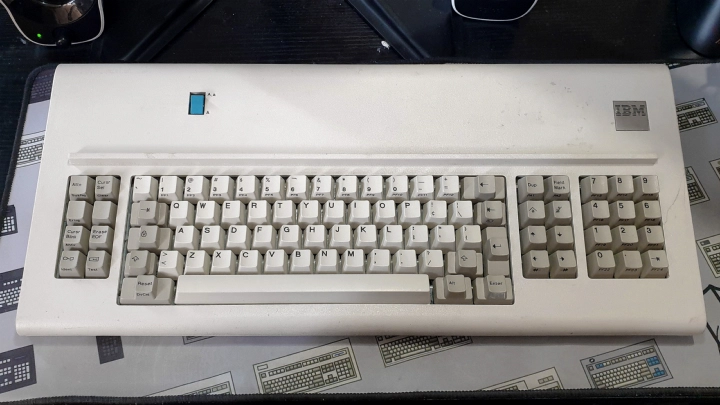
The IBM 3104 Display Terminal and 3178 Display Station were both low-cost terminals announced in December 1982 and March 1983 respectively. The IBM 3104 was intended for IBM 8100 Information System or IBM 4321 and 4331 Processor applications[19], whereas IBM 3178 was designed to be used in a 'traditional' 3270 setting by connecting to an IBM 3274 Control Unit or 3276 Control Unit Display Station[20]. Despite that, both were IBM 3270 Information Display System family terminals and provided IBM 3278 Model 2 equivalent functionality but did not support many 3278 optional features.
Along with its data entry counterpart, the 3104/3178 Typewriter Keyboard is a part of the IBM Base Keyboard family that originated in 1977 during the Model B keyboard era[43]. Specifically, this 87-key [EBCDIC typewriter] keyboard uses the physical layout from the 327X-87 type Model B keyboard. It constituted 3 of the 4 total 3104/3178 keyboard variants, differing by how the right-most keypad and program function (PFxx) keys were utilised and taking their model name after their host; 3104 Model B2, 3178 Model C2, 3178 Model C3 and 3178 Model C4 (there was no 3104 equivalent to the latter two). B2/C2 used an typewriter-like keyboard with a 12-key keypad dedicated to PFxx keys, C3 used an typewriter-like keyboard with a combination 12-key numeric keypad with 24 PFxx legends (2 per key), and C4 used an typewriter-like keyboard with a combination 12-key numeric keypad with 12 PFxx legends[69]. C3 and C4 were also only available in US English and uniquely sport decimal and tab keys on their 12-key keypads[70]. B2 and C2 keyboards seem to share part numbers.
Amongst Model Fs, the 3104/3178 keyboard design was very distinct. They had a large area of unused space above the keys (a trait shared with only the 3101/7485 Terminal Keyboard), with only a single blue-coloured toggle switch and silver-square IBM badge consistently interrupting it. This switch was used for toggling the terminal's display between mixed-case or uppercase-only characters and gives these keyboards their common nickname "blue switch Model F". Some 3104/3178 keyboards may have what appears to be a compartment outline in this area, which was likely the result of shared tooling with the aforementioned 3101/7485 keyboard that had a compartment in this location for covering DIP switches - for 3104/3178 keyboards, it had no purpose. Just above the keys, a very pronounced raised section spanning the width of all the keys was present which can be used to hold small items or layout diagrams in place. Underneath the keyboard, there was a compartment used for storing the host terminals' Problem Determination Guide for convenience. Whilst 3104/3178 keyboards had no native retractable feet for adjusting typing angle, there were clip-on feet (P/N 5641299) available. Another notable feature of the 3104/3178 keyboards was their included solenoids used as a "keyboard clicker" that would engage as an audible confirmation for a registered key. The clicker could be toggled on or off with the bottom-right-most key of the left 4x2 key bank. 3104/3178 keyboards had a grey cable terminating in a male DA-15 plug.
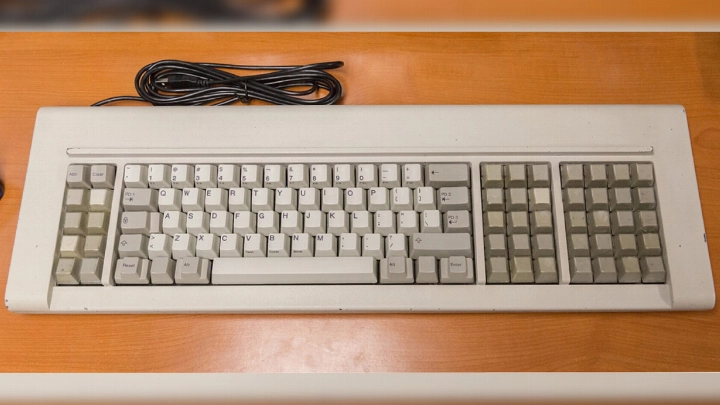
The 107-key IBM 4704 Display Station Model 400 is the largest keyboard for the IBM 4700 Finance Communication System's 4704 Display Station, introduced in December 1983 with the IBM 4704-2. The Model 400 features an additional 30-key transparent-capped keypad on top of the Model 300's 77-key design, making it the most versatile and capable keyboard for the 4704 series. It also has an Alps-made counterpart for the Far Eastern markets.
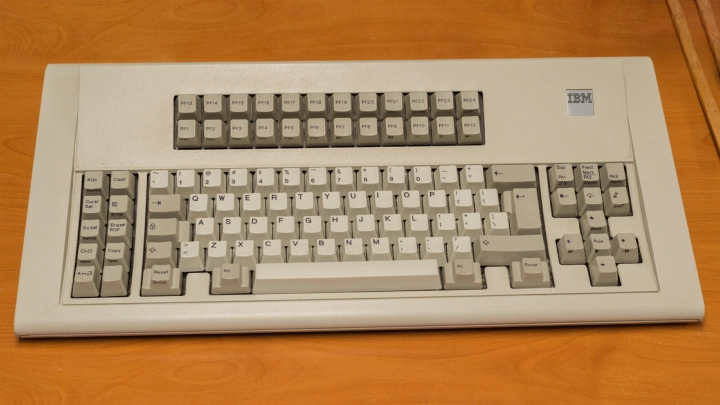
eg, P/Ns 1386965, 1387033, 6016730, 6016732, 6248412, 6248413
The 104-key Model F terminal keyboard was the first in a long line of IBM Converged Keyboards with a distinct 24-key program function key bank placed above the keyboard's alphanumeric keys. Despite a common misconception stating the contrary, the 104-key keyboard came before the more common 122-key Model F ("F122"), beating it to market by several months. The original host terminal for the 104-key keyboard was the IBM 3290 Information Panel, a unique plasma-screen terminal in the IBM 3270/coaxial display station family announced in March 1983[75] (the first "F122" host was the IBM 3270 PC, which was announced in October 1983[76]). This retroactively named "model 1" was replaced by the 3290 Model 2 series in October 1985, which included the models 220 (with 104-key keyboard) and 230 (with 122-key keyboard)[77]. Another host system, the IBM 5080 Graphics System, was announced in November 1983 as a compatible replacement to the IBM 3250 Graphics Display System that was suited for CAD/CAM work and capable of attaching to IBM System/370, 30xx and 43xx processors using 3270 protocol[78].
In addition to the 24-key program function key bank with "PFxx" nomenclature legends, the "F104" has a left-hand side 10-key function key bank similar to previous IBM 3270 keyboard designs such as the 327X-75 type and 327X-87 type Model B keyboards but with 2 extra keys. As a first for 3270-family keyboards, the "F104" sported a layout similar to what would become the "ISO" layout popularised by the IBM Model M Enhanced Keyboard. To adjust the typing angle, the keyboard had two-setting riser feet that were accessible by pushing large buttons on the keyboard's sides. Early press releases and IBM documentation photos of the IBM 3290 Model 1 typically showed a version of the "F104" with a raised border surrounding the rim of the 24-key bank section's raised platform and its silver-square IBM badge placed in the top-left corner down from it. It's unclear if this early version made it into production as no modern examples have been documented. For confirmed production examples, however, the "F104" can be divided into two types based on how they connect to their hosts. As shipped with the IBM 3290-1 and 5080, the Type I "F104" had a modular cable system consisting of a female DA-15 and male DB-25 port - the DA-15 port was for connecting either a 24/25-key Numeric or Program Function Keypad or a lighted program function keypad (LPFK), whilst the DB-25 port was for connecting the keyboard to the host terminal or graphics system. When the IBM 3290 Model 2 was introduced, the Type II "F104" was released with the same 240-degree 5-pin DIN plug "F122s" were introduced with and the DA/DB port area was blocked off with a blanking panel (users who wanted to use the 24/25-key keypad with their 3290 Model 2 was directed to purchasing the 3290-230 with a Type I 122-key Model M instead). It's unclear if the 5080 keyboard was updated the same way. Other minor differences between Type I and II is that Type I "F104s" had an adjustable clicker assembly that can be triggered when pressing keys and 4-pin DIP switch bank, whilst Type IIs lack the clicker and have an 8-position DIP switch bank in a different location to Type I's 4-pin one. The "F104" is colloquially referred to as the "unsaver" by keyboard enthusiasts either for (stemming from the misconception that "F122s" came first) to describe the oxymoronic nature of this keyboard supposedly being a 'space-efficient version' of an even larger ["F122"] keyboard despite the fact "F104" was as large as some modern full-size keyboards, or for simply being a keyboard larger than its layout needed.
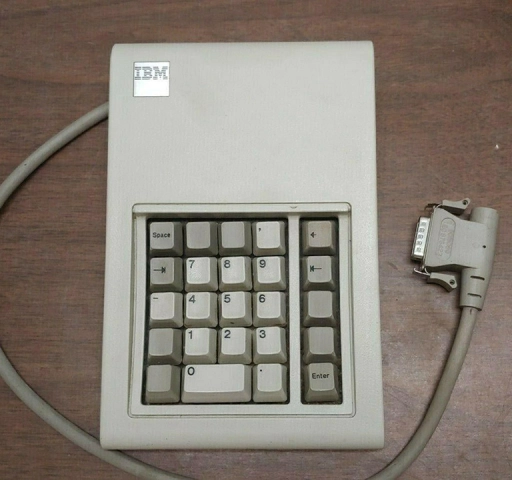
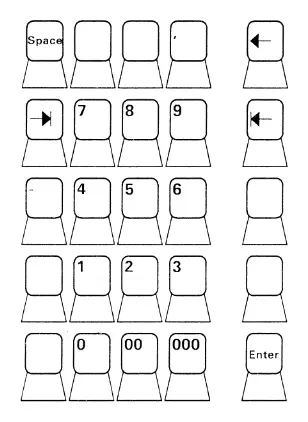
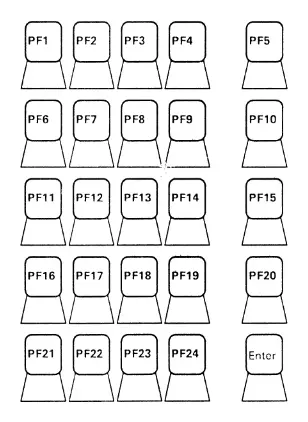
eg, P/Ns 6018100, 6018105, 6018109
The 24/25-key Model F keypad was a peripheral component to 104-key Model F Converged Keyboards, designed to work in tandem with such host keyboards. They are the smallest known Model F based keyboards. They were first introduced for the IBM 3290 Information Panel, a unique plasma-screen terminal in the IBM 3270/coaxial display station family announced in March 1983[75]. In November 1983, the IBM 5080 Graphics System - another host system - was announced as a compatible replacement to the IBM 3250 Graphics Display System that was suited for CAD/CAM work and capable of attaching to IBM System/370, 30xx and 43xx processors using 3270 protocol[78]. When IBM announced the 3290 Model 2 in October 1985, the company directed customers to choose the Model 230 version with a 122-key Model M Converged Keyboard if they wished to continue receiving the 24/25-key Model F's functionality[77].
The 24/25-key Model F was designed to match the same depth profile of the 104-key Model F ("F104"), resulting in a tall, skinny keypad. The keypad was available in two functional layouts, program function and numeric (also referred to as "calculator layout"), with the latter also having several regional and World Trade Country (WTC) variants. All program function and WTC numeric 24/25-key Model Fs had 25 keys, whereas standard numeric keypads had a 2-unit width "0" key resulting in 24 usable keys. Like the "F104", the 24/25-key Model F also had two-setting feet to adjust typing angle, but they were wider and spun most of the keypad's width and weren't side-accessible like the F104's. The keypad had a short, fixed cable with a DA-15 plug, which allowed it to connect to a host 3290-1 or 5080 keyboard (the keypad never connected to a host terminal or graphics system directly). In 1988, IBM introduced the Model M-based IBM Screen Reader Keypad (SRK) that was believed to been produced using modified (cut-down) 24/25-key Model F keypad assembly tooling as the newer keypad's assembly design bears many shared traits such as the barrel plate retaining the holes needed for the 24 or 25-key layout despite the SRK not requiring them.
The IBM 4980 Display Station was a twinaxial terminal for IBM Series/1 minicomputers, announced and released in October 1983. It was designed to be functionally similar to the earlier IBM 4978 Display Station whilst sporting "significantly enhanced ergonomics, expanded keyboard flexibility, reduced cabling and attachment costs and extended cable lengths"[83].
The IBM 4980 used a IBM Converged Keyboard based 127-key Model F, a sibling design to the more common 122-key Model F Converged Keyboard. Both the IBM 4980 and the IBM 3270 Personal Computer (the first terminal/system to use an "F122") were announced the same day (18th October), but whilst the 4980 was made available the same month, 3270 PCs didn't ship until 1984 Q1[76]. On this technicality, the 4980's "F127" was the first "battleship" or "battleship-sized" (as modern enthusiasts call them) Model F keyboard to make it to market. Like the "F122", the 4980 keyboard at its core was an expanded version of the 104-key Model F Converged Keyboard. It's a "function key keyboard" with 24 program function keys with "PFxx" nomenclature legends placed in two rows above the keyboard's main alphanumeric keys. Like the "F104" and "F122", the "F127" came with a left-hand side 10-key function key bank similar to previous IBM 3270 keyboard designs such as the 327X-75 type and 327X-87 type Model B keyboards but with two extra keys. Unlike those keyboards, the "F127" used all usable capacitance-sensing pad pairs on the keyboard's pad card to accommodate its expanded layout. For adjusting typing angle, two-setting riser feet were present and accessible by pushing large buttons on the keyboard's sides. Although unique for "F127" was that the aforementioned buttons were pearl coloured to match the rest of the keyboard's case instead of being grey. The "F127" doesn't feature DIP switches and utilises 240-degree 5-pin DIN plugs on their coiled cables, but unlike "F122s", this keyboard doesn't seem to use IBM scancode set 3 like the "F122" as the keyboard doesn't work with Soarer's Converters[82].
eg, P/Ns 1385151, 1385167, 6110344, 6110345, 6110346, 6110347, 6110668
The 122-key Model F Converged Keyboard was an expanded and prevalent version of the 104-key Model F Converged Keyboards. A sibling of the 127-key 4980 Display Station Typewriter Keyboard, the "F122" could be considered a convenient combination of the "F104" and the 24/25-key Model F keypad that was designed to operate alongside them. The first "F122" to market was the IBM 5271's Converged Keyboard for the IBM 3270 Personal Computer announced in October 1983 and available from Q1 1984, an IBM Personal Computer (5160 PC/XT based) with additional hardware and software to emulate an IBM 3270 terminal[76]. As such, the "F127" (which was announced and released in October 1983[83]) technically beat the "F122" to market. By March 1984, the "F122" was adopted for IBM's then-new generation of lower-cost terminals - the 3179 and 3180 series. The IBM 3179 Model 1 Color Display Station was a low-price but plug-compatible replacement for the IBM 3279 Color Display Station Models S2A and S2B[85]. The IBM 3180 Display Station was a monochrome counterpart to 3179 and was available in a 3270-compatible Model 1 and 5250-compatible Model 2. The 3180-1 was designed to provide IBM 3278 Model 2 through 5 Display Station functionality, and the 3180-2 provided 5251 Model 11 Display Station functionality[86].
Besides its sheer size (for which this keyboard earned the modern nickname "battleship" or "battleship-sized" keyboard), the "F122" is recognisable for its 24-key program function key bank inherited from the "F104". Those keys will generally have a "PFxx" nomenclature on 3270-family keyboards and "Cmdxx" nomenclature on 5250-family keyboards, with some isolated examples sporting simply "Fxx". The "F122" also retained the left-hand side 10-key function key bank similar to previous IBM 3270 keyboard designs such as the 327X-75 type and 327X-87 type Model B keyboards but with 2 extra keys. "F122s" had two-setting riser feet that were accessible by pushing large buttons on the keyboard's sides, allowing users a choice of 6-degree, 12-degree or 18-degree typing angle[85]. Unlike the "F104" however, most "F122s" used 240-degree 5-pin DIN plugs on their coiled cables. 3270 PC, 3179-1 and 3179-G[87] "F122s" generally have an 8-position DIP switch bank present, whilst 3180-1[88] and 3180-2[89] keyboards lack them. Besides the "F127", two distinct variants in utility and features exist - the IBM 3205 Color Display Console Keyboard (3270-family operator console version of "F122") and IBM TPC Keyboard III (TEMPESTed version of the IBM 5271's Converged Keyboard).
The IBM System 9002 Hybrid Keyboard was a Model F/XT-based keyboard designed for the IBM CS/9000. It served as a counterpart to the original System 9000 Family Standard Keyboard that integrated a similar keyboard assembly with a 57-key functional membrane touch panel, replacing the dedicated touch panel found on previous IBM System 9000 family computers. The name "Hybrid" refers to the use of both capacitive buckling spring keyswitches and a membrane touch panel for the keys, which contrasts the Standard Keyboard which was simply a rebadged IBM PC Keyboard with minor modifications. The housing for the keyboard is likely a variation of the IBM 104-key terminal keyboard's case, meaning this is in fact also a hybrid of two Model F keyboard designs. It is very likely the Hybrid Keyboard is the rarest Model F presently known.
The IBM Portable Computer Keyboard was a rehoused Model F/XT made for IBM's first luggable PC - the IBM 5155. Due to its intended use for a portable PC system, the design was lightened by using an all-plastic case and an aluminium keyboard assembly base plate instead of a steel one. The keyboard is also intended to fold up on the front of the host 5155, so there are now two mechanisms on the bottom of the keyboard used for releasing the keyboard so that it can fold down and for detaching the keyboard completely. The keyboard retains a form of riser-style feet, but handles used to fold them down now serve as hinges when the keyboard is coupled to its host and now are also spring-loaded to allow them to be the release mechanism for decoupling the keyboard entirely.
eg, P/Ns 1503092, 6450200, 6450221, 6450222, 6450223, 6450225, 8286165
The IBM Personal Computer AT Keyboard was the successor to the IBM PC and PC/XT Keyboards (Model F/XT) as IBM's main PC keyboard and is the last wholly unique Model F design and capacitive buckling springs host introduced. It was released at the same time as its host PC, the IBM 5170 Personal Computer AT (PC/AT) in August 1984, which was the final major release of the original IBM PC series[26]. What's now commonly referred to as the "Model F/AT" represented a big step towards the now-standard PC keyboard design with its introduction of the ANSI-style large left shift key, separated numeric keypad and LED lock-lights to the IBM keyboard family. However, it would be quickly supplanted by the IBM Model M Enhanced Keyboard within two years. As the name implies, the F/AT uses the "AT" protocol (IBM scancode set 2) like later PS/2 keyboards. This meant that until the 2010s, F/ATs were considered the most valuable Model F keyboards as were amongst the few Model F variants that were easily adaptable to modern systems.
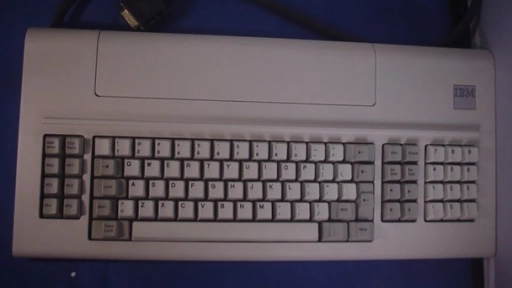
The IBM 3101/7485 Display Terminal Keyboard was a low-profile replacement for the original Model B-based IBM 3101/7485 keyboard and was introduced in August 1984[92]. The IBM 3101 ASCII Display Terminal was a serial-based terminal that used RS-232C and RS-422 for short and long-distance communication respectively[93]. The 3101 was originally rolled out in October 1979[94] and was used with IBM System/1 minicomputers and IBM 8100 Information Systems[68]. The IBM 7485 Display Station is believed to be a 3101-based terminal available under RPQ. The low-profile 3101/7485 keyboard is based on the IBM 3104/3178 Typewriter Keyboard (31XX-87 type Model F) which happens to already use essentially the same physical layout as the original 3101 keyboard and has a compartment useful for the 3101 keyboard's dip switch bank. Notably, the low-profile 3101/7485 keyboard lacks the 3104/3178 keyboard's characteristic blue-coloured switch used for toggling the terminal's display between mixed-case or uppercase-only characters, giving these their nickname "blue switchless" Model F. However, the 3101/7485 keyboard retains a solenoid.
eg, P/Ns 1385082, 1385490, 1385492, 1385494, 1385495, 1385497, 1385498, 1385499, 1385503, 1385504
The IBM 3205 Color Display Console was a colour terminal announced in October 1984 intended for operator console usage for the System/370 compatible IBM 4361 and 4381 processors. It replaced the IBM 3278 Model 2A Display Console and IBM 3279 Model 2C Color Display Console used for earlier IBM 4300 series processors[96].
The 122-key console keyboard for the IBM 3205 was a cosmetic variant of the regular 122-key Model F Converged Keyboard and technically a successor to the 327X-OC type Model B keyboards the IBM 3278-2A and 3279-2C used (which in turn was also a modification of another keyboard). The 3205 "F122" sported characteristic green "Start" and yellow "Stop" keys, reminiscent of the earlier 327X-OC type Model B (albeit those had a red "Stop" key instead). In other respects, the 3205 "F122" is the same as a regular "F122" including having the characteristic 24-key program function key bank with "PFxx" nomenclature, two-setting riser feet for adjustable typing angle, and 240-degree 5-pin DIN plugs on their coiled cables. The 3205 "F122" also had an 8-position DIP switch bank that must be set when the 3205 is connected to a host processor, with the latter 5 switches used in combination to set language. A 124-key Japanese/Katakana version of the keyboard for the IBM 3205 also existed[97].
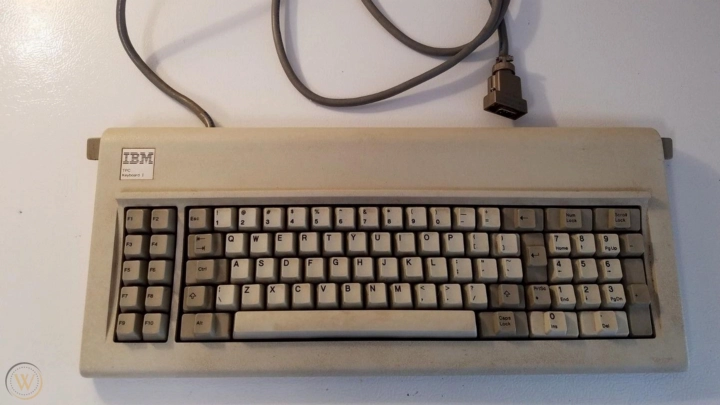
The IBM EMR and TPC I Keyboards were late variants of the Model F/XT featuring different cables and shielding around the internal logic board. These keyboards were designed to be compliant with the shielding specification of codename TEMPEST, a NATO-recognised U.S. National Security Agency specification regarding protecting against spying with electronic equipment. In particular, these keyboards were designed to not radiate electromagnetic emanations to counter Van Eck phreaking. IBM referred to them as 'TEMPESTed' keyboards. The host systems for the EMR Keyboards are unclear, however, the IBM TPC Keyboard I was designed for the IBM 4450 TPC I, a TEMPESTed version of the IBM 5150 PC[99]. EMR "one" Keyboard features a shielded 5-pin DIN plug, however, EMR II Keyboard and IBM TPC Keyboard I have a DE-9 plug. Known part numbers are limited and only US English TEMPESTed Model F keyboards have been found. P/Ns 100A535 and 100A536 are EMR II Keyboards and P/N 4003444 is the TPC I Keyboard.
The IBM 4456 TEMPEST PC III (aka, TPC III or TPC3) was a version of the IBM 3270 Personal Computer[99] that had been 'TEMPESTed' to be compliant with the shielding specification of codename TEMPEST, a NATO-recognised U.S. National Security Agency specification regarding protecting against spying with electronic equipment. In particular, they were designed to not radiate electromagnetic emanations to counter Van Eck phreaking. It's presently unclear when the 4456 was released, but the sole keyboard example found was made in 1986[101].
As its host system is a variant of an existing IBM terminal emulator PC with a 122-key Model F Converged Keyboard (the IBM 5271's Converged Keyboard), the TPC Keyboard III retains the general characteristics of that keyboard. It was a 122-key Model F Converged Keyboard variant with a 24-key program function key bank with "PFxx" nomenclature legends. It also retained the two-setting riser feet that are side accessible to allow the user to change typing angle. However, instead of using a coiled cable terminated with a 240-degree 5-pin DIN plug, the TPC Keyboard III has a straight cable with a DE-9 connector much like other TPC keyboards. Despite the different connector, it's possible the TPC Keyboard III still uses IBM scancode set 3 as EMR II/other TPC keyboards can be passively adapted to the connector of their non-TEMPEST counterparts[102]. The original IBM 5271 keyboard had an 8-position DIP switch bank and it appears that was retained for the TPC Keyboard III, albeit with an additional cover piece. Another difference compared to other "F122s" is that TPC Keyboard III used a 1-unit backspace key and a 2.25-unit left shift key instead of 2-unit and 1.25-unit keys respectively.
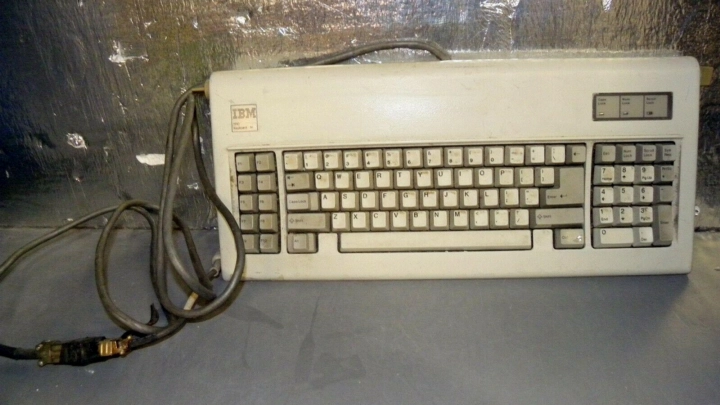
The IBM TPC Keyboard IV was a TEMPESTed version of the Model F/AT. The IBM 4459 TPC IV was a TEMPESTed version of the IBM 5170 PC/AT[99]. Like other TPC keyboards, the TPC Keyboard IV has a DE-9 plug and was designed to be compliant with the shielding specification of codename TEMPEST, a NATO-recognised U.S. National Security Agency specification regarding protecting against spying with electronic equipment. The only known part number is 4010504.
Starting in 2015, Model F Labs has created and sold replicas of two IBM 4704 keyboard designs marketed under their common nicknames; F62 (Model 200) and F77 (Model 300). Model F Labs is solely run by deskthority regular Ellipse. There's a "classic" and modern-esque styled "ultra compact" version of either model available. From most viewable angles, the classic keyboards are largely faithful replicas but there are some changes under the hood and on the bottom. The ultra compact keyboards sports an original case design. In terms of changes from the original IBM 4704 keyboards, these have natively USB-compatible controllers that support xwhatsit or QMK firmware. Vial firmware can also be flashed to allow for easy key remapping and macro creation. The long bottom foot that the original keyboards had has been deleted, replaced by the option to have F/XT-style cork pads to simply prevent the keyboard from sliding around and prevent scratching, or threaded or screwed bumper-style feet for which the classic keyboards have two holes and the ultra compact keyboards have four. The default inclusion varies between the classic and ultra compact[104]. Also gone is the buzzer and control dial for it, replaced by the option to fit a solenoid. Finally and most obviously, the keyboard's default layout has been modernised whilst options for many alternative layouts are given.
Part number list
338 keyboard part numbers have been found in the ASK Keyboard Part Number Database. If you believe a relevant part number is missing, you can help improve this list by requesting a submission for it to be added.
- P/N 100A535: IBM EMR Keyboard II
- P/N 100A536: IBM EMR Keyboard II
- P/N 920460: IBM 5291 Display Station Keyboard Unit
- P/N 985486: IBM 5291 Display Station Keyboard Unit
- P/N 1305671: IBM Electronic Typewriter Models 65, 85 & 95 Keyboard Assembly
- P/N 1305672: IBM Electronic Typewriter Models 65, 85 & 95 Keyboard Assembly
- P/N 1305673: IBM Electronic Typewriter Models 65, 85 & 95 Keyboard Assembly
- P/N 1305674: IBM Electronic Typewriter Models 65, 85 & 95 Keyboard Assembly
- P/N 1305675: IBM Electronic Typewriter Models 65, 85 & 95 Keyboard Assembly
- P/N 1305676: IBM Electronic Typewriter Models 65, 85 & 95 Keyboard Assembly
- P/N 1305677: IBM Electronic Typewriter Models 65, 85 & 95 Keyboard Assembly
- P/N 1305678: IBM Electronic Typewriter Models 65, 85 & 95 Keyboard Assembly
- P/N 1305679: IBM Electronic Typewriter Models 65, 85 & 95 Keyboard Assembly
- P/N 1305680: IBM Electronic Typewriter Models 65, 85 & 95 Keyboard Assembly
- P/N 1305681: IBM Electronic Typewriter Models 65, 85 & 95 Keyboard Assembly
- P/N 1305682: IBM Electronic Typewriter Models 65, 85 & 95 Keyboard Assembly
- P/N 1305683: IBM Electronic Typewriter Models 65, 85 & 95 Keyboard Assembly
- P/N 1305684: IBM Electronic Typewriter Models 65, 85 & 95 Keyboard Assembly
- P/N 1305685: IBM Electronic Typewriter Models 65, 85 & 95 Keyboard Assembly
- P/N 1305686: IBM Electronic Typewriter Models 65, 85 & 95 Keyboard Assembly
- P/N 1305687: IBM Electronic Typewriter Models 65, 85 & 95 Keyboard Assembly
- P/N 1351768: IBM 3270 Personal Computer Converged Keyboard
- P/N 1385072: IBM TPC Keyboard III
- P/N 1385082: IBM 3205 Color Display Console Keyboard Unit
- P/N 1385096: IBM 3270 Personal Computer Converged Keyboard
- P/N 1385151: IBM 3179 Color Graphics Display Station Typewriter Keyboard
- P/N 1385167: IBM 3179 Color Graphics Display Station Typewriter Keyboard
- P/N 1385490: IBM 3205 Color Display Console Keyboard Unit
- P/N 1385491: IBM 3205 Color Display Console Keyboard Unit
- P/N 1385492: IBM 3205 Color Display Console Keyboard Unit
- P/N 1385493: IBM 3205 Color Display Console Keyboard Unit
- P/N 1385494: IBM 3205 Color Display Console Keyboard Unit
- P/N 1385495: IBM 3205 Color Display Console Keyboard Unit
- P/N 1385496: IBM 3205 Color Display Console Keyboard Unit
- P/N 1385497: IBM 3205 Color Display Console Keyboard Unit
- P/N 1385498: IBM 3205 Color Display Console Keyboard Unit
- P/N 1385499: IBM 3205 Color Display Console Keyboard Unit
- P/N 1385500: IBM 3205 Color Display Console Keyboard Unit
- P/N 1385503: IBM 3205 Color Display Console Keyboard Unit
- P/N 1385504: IBM 3205 Color Display Console Keyboard Unit
- P/N 1386543: IBM 3270 Personal Computer Converged Keyboard
- P/N 1386544: IBM 3270 Personal Computer Converged Keyboard
- P/N 1386545: IBM 3270 Personal Computer Converged Keyboard
- P/N 1386853: IBM 3270 Personal Computer Converged Keyboard
- P/N 1386854: IBM 3270 Personal Computer Converged Keyboard
- P/N 1386965: IBM Function Key Keyboard
- P/N 1387033: IBM 3290 Information Panel Data Typewriter Keyboard
- P/N 1397950: IBM 5291 Display Station Keyboard Unit
- P/N 1415880: IBM Electronic Typewriter Models 65, 85 & 95 Keyboard Assembly
- P/N 1415889: IBM Electronic Typewriter Models 65, 85 & 95 Keyboard Assembly
- P/N 1435036: IBM 3180 Display Station APL Keyboard Element
- P/N 1435068: IBM 3180 Display Station Console Keyboard Element
- P/N 1437057: IBM Electronic Typewriter Models 65, 85 & 95 Keyboard Assembly
- P/N 1445095: IBM 3270 Personal Computer Converged Keyboard
- P/N 1445097: IBM 3270 Personal Computer Converged Keyboard
- P/N 1445098: IBM 3270 Personal Computer Converged Keyboard
- P/N 1445099: IBM 3270 Personal Computer Converged Keyboard
- P/N 1445748: IBM 3180 Display Station APL Keyboard Element
- P/N 1445750: IBM 3180 Display Station APL Keyboard Element
- P/N 1445751: IBM 3180 Display Station APL Keyboard Element
- P/N 1445752: IBM 3180 Display Station APL Keyboard Element
- P/N 1445754: IBM 3180 Display Station APL Keyboard Element
- P/N 1445755: IBM 3180 Display Station APL Keyboard Element
- P/N 1445756: IBM 3180 Display Station APL Keyboard Element
- P/N 1445758: IBM 3180 Display Station APL Keyboard Element
- P/N 1445759: IBM 3180 Display Station APL Keyboard Element
- P/N 1445760: IBM 3180 Display Station APL Keyboard Element
- P/N 1445761: IBM 3180 Display Station APL Keyboard Element
- P/N 1445762: IBM 3180 Display Station APL Keyboard Element
- P/N 1501100: IBM Personal Computer Keyboard
- P/N 1501101: IBM Personal Computer Keyboard
- P/N 1501102: IBM Personal Computer Keyboard
- P/N 1501104: IBM Personal Computer Keyboard
- P/N 1501105: IBM Personal Computer Keyboard
- P/N 1503092: IBM Personal Computer AT Keyboard
- P/N 1503206: IBM Personal Computer Keyboard
- P/N 1643374: IBM 5322 System/23 Datamaster Keyboard Assembly
- P/N 1643377: IBM 5322 System/23 Datamaster Keyboard Assembly
- P/N 1643380: IBM 5322 System/23 Datamaster Keyboard Assembly
- P/N 1643383: IBM 5322 System/23 Datamaster Keyboard Assembly
- P/N 1643386: IBM 5322 System/23 Datamaster Keyboard Assembly
- P/N 1643389: IBM 5322 System/23 Datamaster Keyboard Assembly
- P/N 1643392: IBM 5322 System/23 Datamaster Keyboard Assembly
- P/N 1643395: IBM 5322 System/23 Datamaster Keyboard Assembly
- P/N 1801449: IBM Personal Computer Keyboard
- P/N 1860765: IBM 5322 System/23 Datamaster Keyboard Assembly
- P/N 1860768: IBM 5322 System/23 Datamaster Keyboard Assembly
- P/N 1860771: IBM 5322 System/23 Datamaster Keyboard Assembly
- P/N 1860774: IBM 5322 System/23 Datamaster Keyboard Assembly
- P/N 1860777: IBM 5322 System/23 Datamaster Keyboard Assembly
- P/N 1860783: IBM 5322 System/23 Datamaster Keyboard Assembly
- P/N 1860786: IBM 5322 System/23 Datamaster Keyboard Assembly
- P/N 1860789: IBM 5322 System/23 Datamaster Keyboard Assembly
- P/N 2684674: IBM 6580 Displaywriter Display Station Type B Keyboard Module
- P/N 2684691: IBM 6580 Displaywriter Display Station Type B Keyboard Module
- P/N 2684693: IBM 6580 Displaywriter Display Station Type B Keyboard Module
- P/N 4003444: IBM TPC Keyboard I
- P/N 4010504: IBM TPC Keyboard IV
- P/N 4176191: IBM 5291/5292 Display Station Keyboard Unit
- P/N 4176192: IBM 5291/5292 Display Station Keyboard Unit
- P/N 4176193: IBM 5291/5292 Display Station Keyboard Unit
- P/N 4176194: IBM 5291/5292 Display Station Keyboard Unit
- P/N 4176195: IBM 5291/5292 Display Station Keyboard Unit
- P/N 4176196: IBM 5291/5292 Display Station Keyboard Unit
- P/N 4176197: IBM 5291/5292 Display Station Keyboard Unit
- P/N 4176198: IBM 5291/5292 Display Station Keyboard Unit
- P/N 4176199: IBM 5291/5292 Display Station Keyboard Unit
- P/N 4176200: IBM 5291/5292 Display Station Keyboard Unit
- P/N 4176202: IBM 5291/5292 Display Station Keyboard Unit
- P/N 4176203: IBM 5291/5292 Display Station Keyboard Unit
- P/N 4176204: IBM 5291/5292 Display Station Keyboard Unit
- P/N 4176205: IBM 5291/5292 Display Station Keyboard Unit
- P/N 4176206: IBM 5291/5292 Display Station Keyboard Unit
- P/N 4176207: IBM 5291/5292 Display Station Keyboard Unit
- P/N 4176208: IBM 5291/5292 Display Station Keyboard Unit
- P/N 4176209: IBM 5291/5292 Display Station Keyboard Unit
- P/N 4178208: IBM 4980 Display Station 127-key Typewriter Keyboard
- P/N 4733200: IBM Personal Computer Keyboard
- P/N 4742679: IBM 3178 Model C1 Display Station Data Entry Keyboard
- P/N 4742680: IBM 3178 Model C1 Display Station Data Entry Keyboard
- P/N 4742681: IBM 3178 Model C1 Display Station Data Entry Keyboard
- P/N 4742683: IBM 3178 Model C2 Display Station EBCDIC Typewriter Keyboard
- P/N 4742684: IBM 3178 Model C2 Display Station EBCDIC Typewriter Keyboard
- P/N 4742685: IBM 3178 Model C2 Display Station EBCDIC Typewriter Keyboard
- P/N 4742686: IBM 3178 Model C1 Display Station Data Entry Keyboard
- P/N 4742687: IBM 3178 Model C1 Display Station Data Entry Keyboard
- P/N 4742688: IBM 3178 Model C1 Display Station Data Entry Keyboard
- P/N 4742689: IBM 3178 Model C1 Display Station Data Entry Keyboard
- P/N 4742690: IBM 3178 Model C1 Display Station Data Entry Keyboard
- P/N 4742691: IBM 3178 Model C1 Display Station Data Entry Keyboard
- P/N 4742692: IBM 3178 Model C1 Display Station Data Entry Keyboard
- P/N 4742693: IBM 3178 Model C1 Display Station Data Entry Keyboard
- P/N 4742694: IBM 3178 Model C1 Display Station Data Entry Keyboard
- P/N 4742695: IBM 3178 Model C1 Display Station Data Entry Keyboard
- P/N 4742696: IBM 3178 Model C1 Display Station Data Entry Keyboard
- P/N 4742698: IBM 3178 Model C1 Display Station Data Entry Keyboard
- P/N 4742699: IBM 3178 Model C1 Display Station Data Entry Keyboard
- P/N 4742700: IBM 3178 Model C2 Display Station EBCDIC Typewriter Keyboard
- P/N 4742701: IBM 3178 Model C2 Display Station EBCDIC Typewriter Keyboard
- P/N 4742702: IBM 3178 Model C2 Display Station EBCDIC Typewriter Keyboard
- P/N 4742703: IBM 3178 Model C2 Display Station EBCDIC Typewriter Keyboard
- P/N 4742704: IBM 3178 Model C2 Display Station EBCDIC Typewriter Keyboard
- P/N 4742705: IBM 3178 Model C2 Display Station EBCDIC Typewriter Keyboard
- P/N 4742706: IBM 3178 Model C2 Display Station EBCDIC Typewriter Keyboard
- P/N 4742707: IBM 3178 Model C2 Display Station EBCDIC Typewriter Keyboard
- P/N 4742708: IBM 3178 Model C2 Display Station EBCDIC Typewriter Keyboard
- P/N 4742709: IBM 3178 Model C2 Display Station EBCDIC Typewriter Keyboard
- P/N 4742710: IBM 3178 Model C2 Display Station EBCDIC Typewriter Keyboard
- P/N 4742712: IBM 3178 Model C2 Display Station EBCDIC Typewriter Keyboard
- P/N 4742713: IBM 3178 Model C2 Display Station EBCDIC Typewriter Keyboard
- P/N 4780898: IBM System 9000 Family Standard Keyboard
- P/N 5640967: IBM 3178 Model C1 Display Station Data Entry Keyboard
- P/N 5640968: IBM 3178 Model C2 Display Station EBCDIC Typewriter Keyboard
- P/N 5640987: IBM 3178 Model C2 Display Station EBCDIC Typewriter Keyboard
- P/N 5640991: IBM 3178 Model C1 Display Station Data Entry Keyboard
- P/N 5641667: IBM 3178 Model C1 Display Station Data Entry Keyboard
- P/N 5641668: IBM 3178 Model C2 Display Station EBCDIC Typewriter Keyboard
- P/N 5642852: IBM 5291 Display Station Keyboard Assembly
- P/N 5643009: IBM 5291 Display Station Keyboard Assembly
- P/N 5643010: IBM 5291 Display Station Keyboard Assembly
- P/N 5643011: IBM 5291 Display Station Keyboard Assembly
- P/N 5643012: IBM 5291 Display Station Keyboard Assembly
- P/N 5643013: IBM 5291 Display Station Keyboard Assembly
- P/N 5643014: IBM 5291 Display Station Keyboard Assembly
- P/N 5643015: IBM 5291 Display Station Keyboard Assembly
- P/N 5643016: IBM 5291 Display Station Keyboard Assembly
- P/N 5643017: IBM 5291 Display Station Keyboard Assembly
- P/N 5643018: IBM 5291 Display Station Keyboard Assembly
- P/N 5643019: IBM 5291 Display Station Keyboard Assembly
- P/N 5643020: IBM 5291 Display Station Keyboard Assembly
- P/N 5643021: IBM 5291 Display Station Keyboard Assembly
- P/N 5643022: IBM 5291 Display Station Keyboard Assembly
- P/N 5643023: IBM 5291 Display Station Keyboard Assembly
- P/N 5643024: IBM 5291 Display Station Keyboard Assembly
- P/N 5643025: IBM 5291 Display Station Keyboard Assembly
- P/N 5643026: IBM 5291 Display Station Keyboard Assembly
- P/N 5894050: IBM 3104 Model B2 Display Terminal EBCDIC Typewriter Keyboard
- P/N 5894060: IBM 3104 Model B1 Display Terminal Data Entry Keyboard
- P/N 5894248: IBM 3104 Model B2 Display Terminal EBCDIC Typewriter Keyboard
- P/N 6016730: IBM 3290 Information Panel Data Typewriter Keyboard
- P/N 6016732: IBM 3290 Information Panel APL Keyboard
- P/N 6018100: IBM 3290/5080 24-key Numeric Keypad
- P/N 6018102: IBM 3290/5080 24-key Numeric Keypad
- P/N 6018103: IBM 3290/5080 24-key Numeric Keypad
- P/N 6018104: IBM 3290/5080 24-key Numeric Keypad
- P/N 6018105: IBM 3290/5080 25-key Numeric Keypad
- P/N 6018106: IBM 3290/5080 24-key Numeric Keypad
- P/N 6018109: IBM 3290 25-key Program Function Keypad
- P/N 6019273: IBM 4704 Model 100 Functional Keypad
- P/N 6019284: IBM 4704 Model 200 Alphameric Keyboard
- P/N 6019303: IBM 4704 Model 300 Expanded Alphameric Keyboard
- P/N 6019312: IBM 4704 Model 100 Functional Keypad
- P/N 6019315: IBM 4704 Model 100 Functional Keypad
- P/N 6019316: IBM 4704 Model 100 Functional Keypad
- P/N 6019317: IBM 4704 Model 100 Functional Keypad
- P/N 6019318: IBM 4704 Model 100 Functional Keypad
- P/N 6019319: IBM 4704 Model 200 Alphameric Keyboard
- P/N 6019320: IBM 4704 Model 200 Alphameric Keyboard
- P/N 6019323: IBM 4704 Model 200 Alphameric Keyboard
- P/N 6019324: IBM 4704 Model 200 Alphameric Keyboard
- P/N 6019325: IBM 4704 Model 200 Alphameric Keyboard
- P/N 6019326: IBM 4704 Model 200 Alphameric Keyboard
- P/N 6019327: IBM 4704 Model 200 Alphameric Keyboard
- P/N 6019328: IBM 4704 Model 200 Alphameric Keyboard
- P/N 6019329: IBM 4704 Model 200 Alphameric Keyboard
- P/N 6019332: IBM 4704 Model 200 Alphameric Keyboard
- P/N 6019333: IBM 4704 Model 200 Alphameric Keyboard
- P/N 6019334: IBM 4704 Model 200 Alphameric Keyboard
- P/N 6019336: IBM 4704 Model 200 Alphameric Keyboard
- P/N 6019337: IBM 4704 Model 200 Alphameric Keyboard
- P/N 6019338: IBM 4704 Model 300 Expanded Alphameric Keyboard
- P/N 6019339: IBM 4704 Model 300 Expanded Alphameric Keyboard
- P/N 6019342: IBM 4704 Model 300 Expanded Alphameric Keyboard
- P/N 6019343: IBM 4704 Model 300 Expanded Alphameric Keyboard
- P/N 6019344: IBM 4704 Model 300 Expanded Alphameric Keyboard
- P/N 6019345: IBM 4704 Model 300 Expanded Alphameric Keyboard
- P/N 6019346: IBM 4704 Model 300 Expanded Alphameric Keyboard
- P/N 6019347: IBM 4704 Model 300 Expanded Alphameric Keyboard
- P/N 6019348: IBM 4704 Model 300 Expanded Alphameric Keyboard
- P/N 6019351: IBM 4704 Model 300 Expanded Alphameric Keyboard
- P/N 6019352: IBM 4704 Model 300 Expanded Alphameric Keyboard
- P/N 6019353: IBM 4704 Model 300 Expanded Alphameric Keyboard
- P/N 6019355: IBM 4704 Model 300 Expanded Alphameric Keyboard
- P/N 6019356: IBM 4704 Model 300 Expanded Alphameric Keyboard
- P/N 6020218: IBM 4704 Model 400 Administrative Keyboard
- P/N 6020219: IBM 4704 Model 400 Administrative Keyboard
- P/N 6020220: IBM 4704 Model 400 Administrative Keyboard
- P/N 6020222: IBM 4704 Model 400 Administrative Keyboard
- P/N 6020223: IBM 4704 Model 400 Administrative Keyboard
- P/N 6020224: IBM 4704 Model 400 Administrative Keyboard
- P/N 6020225: IBM 4704 Model 400 Administrative Keyboard
- P/N 6020226: IBM 4704 Model 400 Administrative Keyboard
- P/N 6020227: IBM 4704 Model 400 Administrative Keyboard
- P/N 6020228: IBM 4704 Model 400 Administrative Keyboard
- P/N 6020231: IBM 4704 Model 400 Administrative Keyboard
- P/N 6020232: IBM 4704 Model 400 Administrative Keyboard
- P/N 6020233: IBM 4704 Model 400 Administrative Keyboard
- P/N 6020235: IBM 4704 Model 400 Administrative Keyboard
- P/N 6020236: IBM 4704 Model 400 Administrative Keyboard
- P/N 6020237: IBM 4704 Model 400 Administrative Keyboard
- P/N 6020238: IBM 4704 Model 400 Administrative Keyboard
- P/N 6020239: IBM 4704 Model 400 Administrative Keyboard
- P/N 6020240: IBM 4704 Model 400 Administrative Keyboard
- P/N 6020241: IBM 4704 Model 400 Administrative Keyboard
- P/N 6020242: IBM 4704 Model 400 Administrative Keyboard
- P/N 6020243: IBM 4704 Model 400 Administrative Keyboard
- P/N 6052101: IBM 3178 Model C3 Display Station EBCDIC Typewriter Keyboard
- P/N 6052102: IBM 3178 Model C2 Display Station EBCDIC Typewriter Keyboard
- P/N 6052103: IBM 3178 Model C2 Display Station EBCDIC Typewriter Keyboard
- P/N 6052105: IBM 3178 Model C1 Display Station Data Entry Keyboard
- P/N 6052106: IBM 3178 Model C1 Display Station Data Entry Keyboard
- P/N 6052141: IBM 3178 Model C4 Display Station EBCDIC Typewriter Keyboard
- P/N 6110344: IBM 3270 Personal Computer Converged Keyboard (5730)
- P/N 6110345: IBM 3180 Display Station Typewriter Keyboard Element
- P/N 6110346: IBM 3180 Display Station Data Entry Keyboard Element
- P/N 6110347: IBM 3180 Display Station Typewriter Keyboard Element
- P/N 6110348: IBM 3180 Display Station Data Entry Keyboard Element
- P/N 6110625: IBM 3179 Color Display Station Typewriter Keyboard
- P/N 6110668: IBM 3179 Color Display Station Typewriter Keyboard
- P/N 6111034: IBM 3180 Display Station Typewriter Keyboard Element
- P/N 6111035: IBM 3180 Display Station Typewriter Keyboard Element
- P/N 6111036: IBM 3180 Display Station Typewriter Keyboard Element
- P/N 6111037: IBM 3180 Display Station Typewriter Keyboard Element
- P/N 6111038: IBM 3180 Display Station Typewriter Keyboard Element
- P/N 6111039: IBM 3180 Display Station Typewriter Keyboard Element
- P/N 6111040: IBM 3180 Display Station Typewriter Keyboard Element
- P/N 6111041: IBM 3180 Display Station Typewriter Keyboard Element
- P/N 6111042: IBM 3180 Display Station Typewriter Keyboard Element
- P/N 6111043: IBM 3180 Display Station Typewriter Keyboard Element
- P/N 6111044: IBM 3180 Display Station Typewriter Keyboard Element
- P/N 6111045: IBM 3180 Display Station Typewriter Keyboard Element
- P/N 6111079: IBM 3180 Display Station Typewriter Keyboard Element
- P/N 6111080: IBM 3180 Display Station Typewriter Keyboard Element
- P/N 6111081: IBM 3180 Display Station Typewriter Keyboard Element
- P/N 6111082: IBM 3180 Display Station Typewriter Keyboard Element
- P/N 6111085: IBM 3180 Display Station Typewriter Keyboard Element
- P/N 6111086: IBM 3180 Display Station Typewriter Keyboard Element
- P/N 6111087: IBM 3180 Display Station Typewriter Keyboard Element
- P/N 6111088: IBM 3180 Display Station Typewriter Keyboard Element
- P/N 6111089: IBM 3180 Display Station Typewriter Keyboard Element
- P/N 6111090: IBM 3180 Display Station Typewriter Keyboard Element
- P/N 6111091: IBM 3180 Display Station Typewriter Keyboard Element
- P/N 6111092: IBM 3180 Display Station Typewriter Keyboard Element
- P/N 6111235: IBM Portable Personal Computer Keyboard
- P/N 6124531: IBM 3178 Typewriter Keyboard
- P/N 6248412: IBM 5080 Graphics System Alphameric Keyboard
- P/N 6248413: IBM 5080 Graphics System Alphameric Keyboard
- P/N 6248414: IBM 5080 Graphics System Alphameric Keyboard
- P/N 6248415: IBM 5080 Graphics System Alphameric Keyboard
- P/N 6248416: IBM 5080 Graphics System Alphameric Keyboard
- P/N 6248417: IBM 5080 Graphics System Alphameric Keyboard
- P/N 6248418: IBM 5080 Graphics System Alphameric Keyboard
- P/N 6248419: IBM 5080 Graphics System Alphameric Keyboard
- P/N 6248420: IBM 5080 Graphics System Alphameric Keyboard
- P/N 6248421: IBM 5080 Graphics System Alphameric Keyboard
- P/N 6248422: IBM 5080 Graphics System Alphameric Keyboard
- P/N 6248423: IBM 5080 Graphics System Alphameric Keyboard
- P/N 6248431: IBM 5080 Graphics System Alphameric Keyboard
- P/N 6248432: IBM 5080 Graphics System Alphameric Keyboard
- P/N 6450200: IBM Personal Computer AT Keyboard
- P/N 6450221: IBM Personal Computer AT Keyboard
- P/N 6450222: IBM Personal Computer AT Keyboard
- P/N 6450223: IBM Personal Computer AT Keyboard
- P/N 6450225: IBM Personal Computer AT Keyboard
- P/N 6450304: IBM Portable Personal Computer Keyboard
- P/N 7363290: IBM 5291 Display Station Keyboard Assembly
- P/N 8116083: IBM Personal Computer Keyboard
- P/N 8223422: IBM Personal Computer AT Keyboard
- P/N 8223423: IBM Personal Computer AT Keyboard
- P/N 8257794: IBM 5324 System/23 Datamaster Keyboard Module
- P/N 8257796: IBM 5324 System/23 Datamaster Keyboard Module
- P/N 8286165: IBM Personal Computer AT Keyboard
- P/N 8323237: IBM 3101 ASCII Display Terminal Keyboard
- P/N 8323238: IBM 3101 ASCII Display Terminal Keyboard
- P/N 8323239: IBM 7485 Display Station Keyboard
- P/N 8529297: IBM Personal Computer Keyboard
- P/N 8529401: IBM 5324 System/23 Datamaster Keyboard Module
- P/N 8529404: IBM 5324 System/23 Datamaster Keyboard Module
- P/N 8529406: IBM 5324 System/23 Datamaster Keyboard Module
- P/N 8529408: IBM 5324 System/23 Datamaster Keyboard Module
- P/N 8529410: IBM 5324 System/23 Datamaster Keyboard Module
- P/N 8529412: IBM 5324 System/23 Datamaster Keyboard Module
- P/N 8529414: IBM 5324 System/23 Datamaster Keyboard Module
- P/N 8529416: IBM 5324 System/23 Datamaster Keyboard Module
- P/N 8529418: IBM 5324 System/23 Datamaster Keyboard Module
- P/N 8529420: IBM 5324 System/23 Datamaster Keyboard Module
- P/N 8529422: IBM 5324 System/23 Datamaster Keyboard Module
- P/N 8529424: IBM 5324 System/23 Datamaster Keyboard Module
- P/N 8529426: IBM 5324 System/23 Datamaster Keyboard Module
- P/N 8529428: IBM 5324 System/23 Datamaster Keyboard Module
- P/N 8654422: IBM Portable Personal Computer Keyboard
- P/N 8654428: IBM Portable Personal Computer Keyboard
- P/N 8654430: IBM Portable Personal Computer Keyboard
- P/N 8654431: IBM Portable Personal Computer Keyboard
- P/N 8654432: IBM Portable Personal Computer Keyboard
- P/N 9002-UNK: IBM System 9002 Hybrid Keyboard
- P/N F62: Model F Labs F62 Model F Keyboard
- P/N F77: Model F Labs F77 Model F Keyboard
- IBM 3101/7485 ASCII Display Terminal Keyboard
- IBM 3104-B1/3178-C1 Data Entry Keyboard
- IBM 3104-B2/3178-C2 Typewriter Keyboard
- IBM 3178-C3 Typewriter Keyboard
- IBM 3178-C4 Typewriter Keyboard
- IBM 3179 Color Graphics Display Station Typewriter Keyboard
- IBM 3180 Model 1 Display Station Typewriter Keyboard Element
- IBM 3180 Model 2 Display Station Typewriter Keyboard Element
- IBM 3205 Color Display Console Keyboard Unit
- IBM 3270 Personal Computer Converged Keyboard (aka IBM 5271 Personal Computer Converged Keyboard)
- IBM 3290 Model 1 Information Panel Data Typewriter Keyboard
- IBM 3290 Model 1/5080 Converged Keyboard Numeric Keypad
- IBM 4704 Display Station Model 100 Function Keyboard (aka "Model F50")
- IBM 4704 Display Station Model 200 Alphameric Keyboard (aka "Model F62" or "kishsaver")
- IBM 4704 Display Station Model 300 Expanded Alphameric Keyboard (aka "Model F77")
- IBM 4704 Display Station Model 400 Administrative Keyboard (aka "Model F107")
- IBM 4980 Display Station Typewriter Keyboard
- IBM 5291/5292 Display Station Keyboard
- IBM 5322 System/23 Datamaster Keyboard Assembly
- IBM 5324 System/23 Datamaster Floortop Keyboard Module
- IBM 6580 Displaywriter Display Station Type B Keyboard (96-character variant)
- IBM Electronic Typewriter 65/85/95 Keyboard Assembly
- IBM Personal Computer AT Keyboard (aka "Model F/AT")
- IBM Personal Computer Keyboard (aka "Model F/XT")
- IBM Portable Personal Computer Keyboard
- IBM System 9001 Standard Keyboard (aka IBM Instruments Computer System 9000 Keyboard)
- IBM System 9002 Hybrid Keyboard
- IBM TPC Keyboard I
- IBM TPC Keyboard III
- IBM TPC Keyboard IV
Internal
- IBM - Catastrophically buckling compression column switch and actuator [accessed 2024-12-25].
- IBM - SCHALTTASTE MIT EINER SCHNAPPMECHANIK [accessed 2024-12-25].
- IBM - Buckling spring torsional snap actuator [accessed 2024-12-25].
- OS/2 Museum - The IBM PC, 41 Years Ago [accessed 2024-12-25].
- IBM - SiteLine June 1982 [accessed 2025-02-12]. License/note: photo excerpts used under fair dealing.
- Wikipedia - IBM System/23 Datamaster [accessed 2024-12-25].
- snuci - File:IBM 5322 - computer.JPG [accessed 2024-12-25]. License/note: public domain.
- Wikipedia - IBM Personal Computer [accessed 2023-01-05].
- Byte Magazine - Volume 07 Number 01 - The IBM Personal Computer [accessed 2022-07-04].
- Wikipedia - IBM Personal Computer XT [accessed 2023-01-05].
- Joe/Ellipse @ modelfkeyboards.com - 500+ photos of my IBM Keyboards [accessed 2022-05-02]. License/note: permission requested and explicitly given via direct correspondence.
- IBM - IBM 4700 Finance Communication System Overview (#ZG81-0246) [accessed 2025-02-12].
- IBM - IBM Hardware List as of 12/15/87 [accessed 2025-12-12].
- IBM - IBM 5291 Display Station Announced (#ZG82-0274) [accessed 2025-12-12].
- IBM - IBM 5292 Colour Display Station Announced Brief Description of Announcement, Charges, and Availability (#ZG82-0275) [accessed 2025-12-12].
- IBM - IBM 5291 Display Station Parts Catalog (#S131-0635-0) [accessed 2025-12-12].
- kishy.ca - The IBM 4704 [accessed 2022-07-04].
- webwit - Index of /input/ibm_misc [accessed 2023-01-06]. License/note: public domain.
- IBM - IBM 3104 Display Terminal Brief Description of Announcement, Charges, and Availability (#ZG82-0322) [accessed 2023-01-06].
- IBM - IBM 3178 Display Station Brief Description of Announcement, Charges, and Availability (#183-034) [accessed 2023-01-06].
- IBM - IBM 3178 Display Station Model C4 Announced Brief Description of Announcement, Charges, and Availability (#184-015) [accessed 2023-01-19].
- IBM - IBM 3290 Information Panel Brief Description of Announcement, Charges, and Availability (#183-033) [accessed 2024-12-25].
- IBM - IBM 4980 Display Station Model 1 Announced Attaches to Series/1 via New Feature (#1250) Brief Description of Announcement, Charges, and Availability (#183-136) [accessed 2024-12-26].
- IBM - IBM 3270 Personal Computer Brief Description of Announcement, Charges, and Availability (#186-117) [accessed 2024-12-26].
- Wikipedia - IBM Portable Personal Computer [accessed 2022-07-04].
- Wikipedia - IBM Personal Computer AT [accessed 2023-03-04].
- kishy.ca - IBM 1387033: Space Unsaver [accessed 2022-07-04].
- IBM - Withdrawal: Selected PC Features, Options, and Publications (#194-263) [accessed 2022-07-04].
- deskthority - IBM Model F 1397950 "Bigfoot" [accessed 2022-07-04].
- Los Angeles Times - IBM Planning to Set Up New Subsidiary : Industry: A buyout firm will be the majority owner of its typewriter and keyboard operations [accessed 2021-09-01].
- Unicomp - IBM 5291 Model F Keyboard [accessed 2022-07-04].
- Shaddim - File:Bucklingspring-animation-300ms.gif [accessed 2021-09-09]. License/note: CC-BY-2.0.
- snuci - File:IBM PC Model F Type 1 - capacitive PCB.JPG [accessed 2022-11-05]. License/note: public domain.
- deskthority - Replacement foam in IBM Model F [accessed 2022-07-01].
- WASD Keyboards - Mechanical Keyboard Guide [accessed 2022-07-01].
- Switch And Click - ABS vs PBT Keycaps: What’s the Difference? [accessed 2021-09-09].
- Unicomp - Buttons [accessed 2021-09-15].
- phosphorglow - IBM "Shop Date" [accessed 2021-12-19].
- C. Hurlbut - 1982 F [accessed 2021-09-13]. License/note: copyright @ Christopher Hurlbut (explicit permission to use here given).
- eBay Kleinanzeigen - photos saved from past listings & used under fair dealing.
- eBay - photos saved from past listings & used under fair dealing.
- Engicoder - File:Cs-9000-rear-plate.JPG [accessed 2024-02-05]. License/note: public domain.
- Admiral Shark's Keyboards - Official names discovered for IBM 75/87/104/122 key terminal keyboards [accessed 2023-09-25].
- snuci - File:IBM 5322 - barrel plate front.JPG [accessed 2024-03-18]. License/note: public domain.
- snuci - File:IBM 5322 - back plate with PCB.JPG [accessed 2024-03-18]. License/note: public domain.
- Wikipedia - IBM System/23 Datamaster [accessed 2024-06-30].
- IBM - IBM 5324 Computer Announced (#ZG82-0218) [accessed 2024-06-30].
- IBM - The IBM PC [accessed 2024-06-30]. License/note: retrieved via Wayback Machine (2024-05-30 capture).
- IBM - IBM 5322 Computer Service Manual (#SY34-0171-0) [accessed 2024-11-22]. License/note: hosted on Mark's Tech Journal.
- IBM - IBM Commonly Used Systems Parts Handbook (#ZA38-0016-0) [accessed 2024-11-22]. License/note: archived by bitsavers.
- IBM - IBM 5324 Computer Service Manual (#SY34-0241-0) [accessed 2024-11-22]. License/note: hosted on Mark's Tech Journal.
- Rama - File:IMB PC-IMG 7277.jpg [accessed 2023-01-04]. License/note: CC BY-SA 2.0 FR.
- zrrion - donated photo. License/note: CC BY-NC-SA 4.0.
- emdude @ deskthority - IBM Electronic Typewriter Model 95 - Capacitive Buckling Springs [accessed 2025-04-19]. License/note: photos used under fair dealing.
- IBM - IBM Electronic Typewriters 85 and 65 Announced, IBM Electronic Typewriters 50, 60, 75 and 175 Production Status Changed to "As Available" Announcement Letter (#ZG82-0308) [accessed 2025-04-19].
- IBM - IBM Electronic Typewriter Announcements Announcement Letter (#184-003) [accessed 2025-04-19].
- IBM - IBM Electronic Typewriter 95, IBM Electronic Typewriter 85 Improvements, IBM Typewriter Diskette Module and IBM Typewriter Modularity Option Announced Announcement Letter (#ZG84-0213) [accessed 2025-04-19].
- IBM - IBM 5291 Display Station Maintenance Library (#SY31-0661-0) [accessed 2023-01-04]. License/note: document archived by bitsavers, illustrations used under fair dealing.
- bitsavers - Index of /pdf/ibm/5291/5291-2_pictures [accessed 2023-01-04]. License/note: believed to be public domain.
- IBM - IBM Data Communications Concepts (#GC21-5169-4) [accessed 2023-01-04]. License/note: document archived by bitsavers, illustrations used under fair dealing.
- WorthPoint - VINTAGE IBM Keyboard Part# 5642852 [accessed 2023-02-04]. License/note: used under fair dealing.
- IBM - IBM 5291 Models 1 and 2 Display Station Operator's Guide (#GA21-9409-2) [accessed 2023-01-21]. License/note: document archived by bitsavers.
- Engicoder - File:CS-9000-Front.JPG [accessed 2022-04-17]. License/note: public domain.
- IBM - photos used under fair dealing (source lost).
- Wikipedia - IBM Displaywriter System [accessed 2022-11-27].
- IBM - Low Profile Keyboard for the IBM 6580 Displaywriter System Announced (#ZG82-0309) [accessed 2022-12-19].
- elecplus - photos used under request.
- IBM - An Introduction to the IBM 8100 Information System (#GA27-2875-7) [accessed 2023-01-16]. License/note: document archived by bitsavers, photos used under fair dealing.
- IBM - IBM 3178 Display Station Operator Reference Guide (#GA18-2128-3) [accessed 2022-11-27]. License/note: diagram used under fair dealing.
- IBM - IBM 3270 Information Display Station Character Set Reference (#GA27-2837-9) [accessed 2022-11-27].
- bitsavers - IBM 3270 Information Display System Introduction (#GA27-2739-18) [accessed 2023-07-31]. License/note: document archived by bitsavers, photos used under fair dealing.
- IBM - IBM 3270 Information Display System Introduction (#GA27-2739-22) [accessed 2023-01-23]. License/note: document archived by bitsavers, photos used under fair dealing.
- safedork - donated photos. License/note: CC BY-NC-SA 4.0.
- ASK Keyboard Archive - P/N 1386965 (1985, IBM-US) [accessed 2023-08-01]. License/note: photos saved from WorthPoint, used under fair dealing.
- IBM - IBM 3290 Information Panel Brief Description of Announcement, Charges, and Availability (#183-033) [accessed 2023-01-23].
- IBM - IBM 3270 Personal Computer Brief Description of Announcement, Charges, and Availability (#186-117) [accessed 2023-01-23].
- IBM - IBM 3290 Information Panel Models 220 and 230 Replace IBM 3290 Model 1 Brief Description of Announcement, Charges, and Availability (#185-115) [accessed 2023-04-11].
- IBM - IBM 5080 Graphics System for High Performance CAD/CAM, Data, and Engineering/Scientific Graphics Brief Description of Announcement, Charges, and Availability (#183-145) [accessed 2023-07-31].
- ASK Keyboard Archive - P/N 6018100 (1985, IBM-US) [accessed 2022-05-02]. License/note: photos saved from WorthPoint, used under fair dealing.
- bitsavers - IBM 3290 Information Panel Description and Reference (#GA23-0021-0) [accessed 2023-08-01]. License/note: document archived by bitsavers, diagrams used under fair dealing.
- bitsavers - IBM Series/1 Customer Site Preparation Manual (#GA34-0050-8) [accessed 2023-08-02]. License/note: document archived by bitsavers, diagrams used under fair dealing.
- Wazrach @ deskthority - IBM 4980 Model F Battleship (DONE) [accessed 2023-08-03]. License/note: permission to use photos requested and given via DMs.
- IBM - IBM 4980 Display Station Model 1 Announced Attaches to Series/1 via New Feature (#1250) Brief Description of Announcement, Charges, and Availability (#183-136) [accessed 2023-08-03].
- IBM - IBM System/36 Equipment and programs (#G580-0451-02) [accessed 2023-01-23]. License/note: document archived by bitsavers, photos used under fair dealing.
- IBM - IBM 3179 Color Display Station Brief Description of Announcement, Charges, and Availability (#184-039) [accessed 2023-01-23].
- IBM - IBM 3180 Display Station Models 1 and 2 Brief Description of Announcement, Charges, and Availability (#184-040) [accessed 2023-01-23].
- ASK Keyboard Archive - P/N 1385151 (1985, IBM-US) [accessed 2023-08-01]. License/note: photos donated by theMK#1822, CC BY-NC-SA 4.0.
- kishy - IBM 6110345: 122-key Model F [accessed 2023-08-01].
- ASK Keyboard Collection - SNKB-F1986-FBS-122 [accessed 2023-08-01]. License/note: CC-BY-NC-SA 4.0.
- Norsk Teknisk Museum - NTM TELE IBM 2012 55002 [accessed 2025-04-19]. License/note: CC BY-SA 4.0 (cropped).
- daedalus - File:3101ModelF.jpg [accessed 2022-05-03]. License/note: permission requested and explicitly given via direct messaging.
- IBM - IBM 3101/7485 Display Stations Enhanced Brief Description of Announcement, Charges, and Availability (#184-154) [accessed 2023-01-20].
- Wikipedia - IBM 3101 [accessed 2022-11-27].
- IBM - DPD chronology page 5 [accessed 2022-11-27].
- Jugostran#2852 - donated photos. License/note: CC BY-NC-SA 4.0.
- IBM - IBM 3205 Color Display Console Brief Description of Announcement, Charges, and Availability (#184-149) [accessed 2022-12-19].
- IBM - IBM 3205 Color Display Console Maintenance Information (#SY18-2121-1) [accessed 2023-10-10]. License/note: document archived by bitsavers.
- WorthPoint - Extremely Rare Vintage IBM TPC Keyboard I - Clicky - Similar to PC XT Model F [accessed 2022-07-04]. License/note: used under fair dealing.
- IBM - IBM Personal System/2 and IBM Personal Computer Product Reference Version 4.0 (#102682986) [accessed 2022-07-04].
- IBM - IBM Personal Computer Family Service Information Manual (#SA38-0037-00) [accessed 2023-08-03]. License/note: document archived by bitsavers, diagrams used under fair dealing.
- WorthPoint - RARE VERSION IBM Model F TPC Keyboard iii 1385072, Vintage 1986 with Cover [accessed 2022-07-04]. License/note: used under fair dealing.
- daneli @ deskthority - Using the EMR II keyboard [accessed 2023-08-03].
- WorthPoint - Vintage IBM Model F TPC IV Clicky Key Mechanical Keyboard 4010504 [accessed 2022-07-04]. License/note: used under fair dealing.
- Model F Labs - Keyboard Feet / Bumpers [accessed 2022-08-21].
| Published | Comment |
|---|---|
| 19th April 2025 | Added full system photo for IBM Portable Personal Computer Keyboard (1984) sub-section |
| 19th April 2025 | Rewrote the "Electronic Typewriter Models 65, 85 and 95 (1982)" subsection, added "Directory entries" section, simplified "Keyboards" section's table and added link to "Major IBM typewriter & keyboard models" under Further reading & resources -> Internal |
| 12th February 2025 | Updated "History" section with fact on Model F production start in Raleigh in early 1982, corrected dates surrounding 4704 and 529X and a fact regarding how much of Model F production was PC keyboards in 1982 |
| 4th January 2025 | Tweaks to wording in the "PBT dye-sublimated keycaps" subsection |
| 26th December 2024 | Corrected "472X-400" to "470X-400", improved the "History" with 1978-1980 events and general tweaks/corrections |
